Correlated-Electron Systems and High-Temperature Superconductivity ()
1. Introduction
The effect of the strong correlation between electrons is important for many quantum critical phenomena, such as unconventional superconductivity (SC) and the metalinsulator transition. Typical correlated electron systems are high-temperature superconductors [1-5], heavy fermions [6-9] and organic conductors [10]. The phase diagram for the typical high-Tc cuprates is shown in Figure 1 [9]. It has a characteristics that the region of antiferromagnetic order exists at low carrier concentrations and the superconducting phase is adjacent to the antiferromagnetism.
In the low-carrier region shown in Figure 2, there is the anomalous metallic region where the susceptibility and  show a peak above Tc suggesting an existence of the pseudogap. To clarify an origin of the anomalous metallic behaviors is also a subject attracting many physicists as a challenging problem.
show a peak above Tc suggesting an existence of the pseudogap. To clarify an origin of the anomalous metallic behaviors is also a subject attracting many physicists as a challenging problem.
It has been established that the Cooper pairs of high-Tc cuprates have the  -wave symmetry in the hole-doped materials [11,12]. Several evidences of
-wave symmetry in the hole-doped materials [11,12]. Several evidences of  -wave pairing
-wave pairing
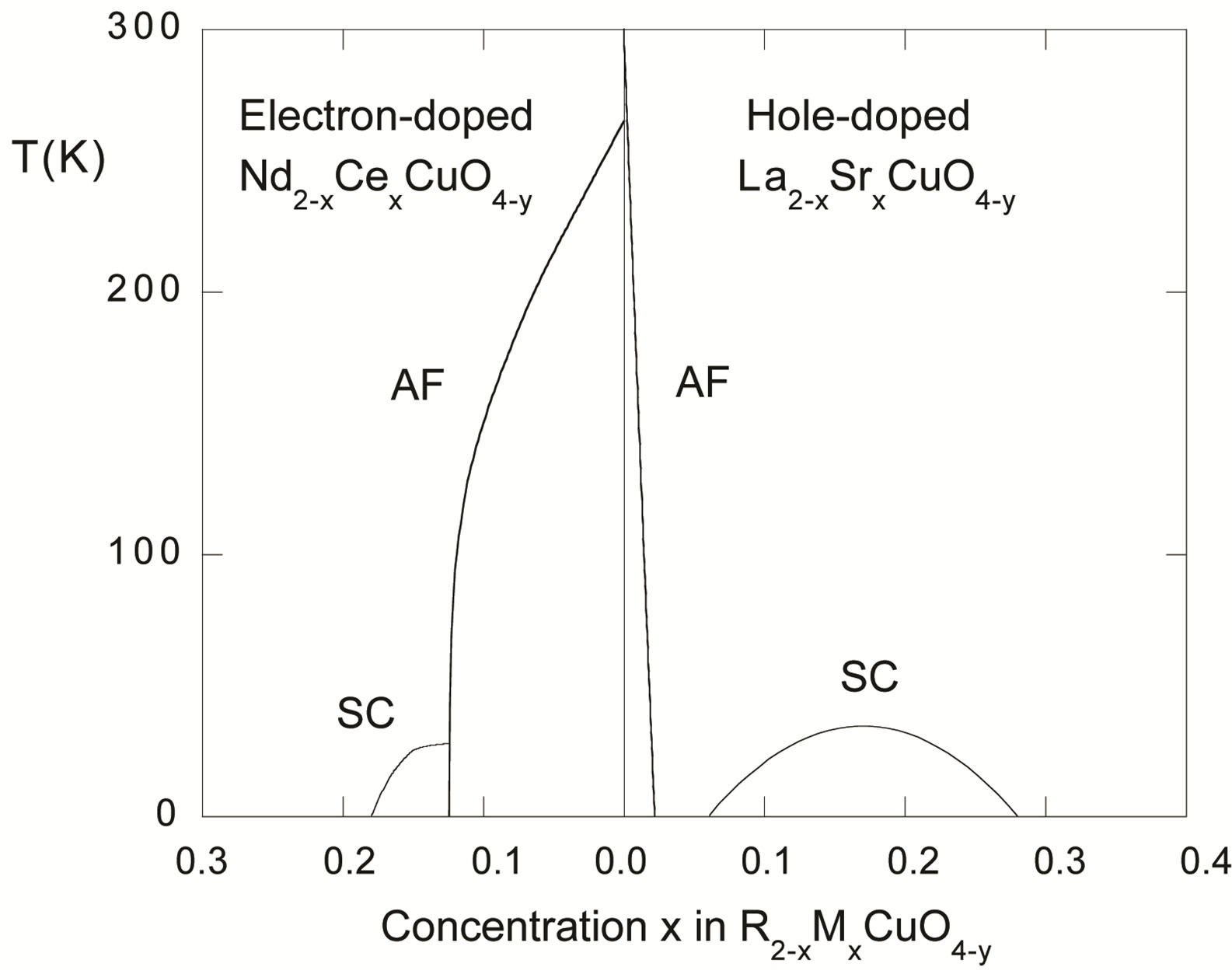
Figure 1. Phase diagram delineating the regions of superconductivity and antiferromagnetic ordering of the Cu2+ ions for the hole-doped La2–xSrxCuO4 and electron-doped Nd2–xCexCuO4–y systems.

Figure 2. Phase diagram showing the regions of non-Fermi liquid and pseudogap metal for the hole-doped case. The boundaries indicated in the figure are not confirmed yet.
symmetry were provided for the electron-doped cuprates Nd2–xCexCuO4 [13-15]. Thus it is expected that the superconductivity of electronic origin is a candidate for the high-Tc superconductivity. We can also expect that the origin of  -wave superconductivity lies in the onsite Coulomb interaction of the two-dimensional Hubbard model.
-wave superconductivity lies in the onsite Coulomb interaction of the two-dimensional Hubbard model.
The antiferromagnetism should also be examined in correlated electron systems. The undoped oxide compounds exhibit rich structures of antiferromagnetic correlations over a wide range of temperature that are described by the two-dimensional quantum antiferromagnetism [16-18]. A small number of holes introduced by doping are responsible for the disappearance of long-range antiferromagnetic order [19-24].
Recent neutron scattering experiments have suggested an existence of incommensurate ground states with modulation vectors given by  and
and  (or
(or  and
and  ) where
) where  denotes the hole-doping ratio [25]. We can expect that the incommensurate correlations are induced by holes doped into the Cu-O plane in the underdoped region. A checkerboard-like charge-density modulation with a roughly
denotes the hole-doping ratio [25]. We can expect that the incommensurate correlations are induced by holes doped into the Cu-O plane in the underdoped region. A checkerboard-like charge-density modulation with a roughly  period has also been observed by scanning tunneling microscopy experiments in Bi2212 and Na-CCOC compounds.
period has also been observed by scanning tunneling microscopy experiments in Bi2212 and Na-CCOC compounds.
Recently the mechanism of superconductivity in hightemperature superconductors has been extensively studied using various two-dimensional (2D) models of electronic interactions. Among them the 2D Hubbard model [26] is the simplest and most fundamental model. This model has been studied intensively using numerical tools, such as the Quantum Monte Carlo method [27-42], and the variational Monte Carlo method [24,43-50]. The two-leg ladder Hubbard model was also investigated with respect to the mechanism of high-temperature superconductivity [51-59].
Since the discovery of cuprate high-temperature superconductors, many researchers have tried to explain the occurrence of superconductivity of these materials in terms of the two-dimensional (2D) Hubbard model. However, it remains matter of considerable controversial as to whether the 2D Hubbard model accounts for the properties of high-temperature cuprate superconductors. This is because the membership of the the two-dimensional Hubbard model in the category of strongly correlated systems is a considerable barrier to progress on this problem. The quest for the existence of a superconducting transition in the 2D Hubbard model is a long-standing problem in correlated-electron physics, and has been the subject of intensive study [35,36,38,46, 60,61]. In particular, the results of quantum Monte Carlo methods, which are believed to be exact unbiased methods, have failed to show the existence of superconductivity in this model [38,61].
In the weak coupling limit we can answer this question. We can obtain the superconducting order parameter of the Hubbard model in the limit of small , that is given by [62-66]
, that is given by [62-66]
 (1)
(1)
where  is the strength of the on-site Coulomb interaction and the exponent
is the strength of the on-site Coulomb interaction and the exponent  is determined by solving the gap equation. Thus the existence of the superconducting gap is guaranteed by the weak coupling theory although
is determined by solving the gap equation. Thus the existence of the superconducting gap is guaranteed by the weak coupling theory although  is extremely small because of the exponential behavior given above.
is extremely small because of the exponential behavior given above.  indicates the strength of superconductivity. In the intermediate or large coupling region, we must study it beyond the perturbation theory.
indicates the strength of superconductivity. In the intermediate or large coupling region, we must study it beyond the perturbation theory.
We investigate the ground state of the Hubbard model by employing the variational Monte Carlo method. In the region , the finite superconducting gap is obtained by using the quantum variational Monte Carlo method. The superconducting condensation energy obtained by adopting the Gutzwiller ansatz is in reasonable agreement with the condensation energy derived for YBa2Cu3O7. We have further investigated the stability of striped and checkerboard states in the under-doped region. Holes doped in a half-filled square lattice lead to an incommensurate spin and charge density wave. The relationship of the hole density x and incommensurability
, the finite superconducting gap is obtained by using the quantum variational Monte Carlo method. The superconducting condensation energy obtained by adopting the Gutzwiller ansatz is in reasonable agreement with the condensation energy derived for YBa2Cu3O7. We have further investigated the stability of striped and checkerboard states in the under-doped region. Holes doped in a half-filled square lattice lead to an incommensurate spin and charge density wave. The relationship of the hole density x and incommensurability ,
, 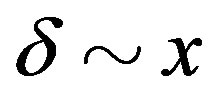 , is satisfied in the lower doping region. This is consistent with the results by neutron scattering measurements. To examine the stability of a
, is satisfied in the lower doping region. This is consistent with the results by neutron scattering measurements. To examine the stability of a  checkerboard state, we have performed a variational Monte Carlo simulation on a two-dimensional
checkerboard state, we have performed a variational Monte Carlo simulation on a two-dimensional  Hubbard model with a Bi-2212 type band structure. We found that the
Hubbard model with a Bi-2212 type band structure. We found that the  period checkerboard checkerboard spin modulation that is characterized by multi
period checkerboard checkerboard spin modulation that is characterized by multi  vectors is stabilized.
vectors is stabilized.
Further investigation has been performed by using the quantum Monte Carlo method which is a numerical method that can be used to simulate the behavior of correlated electron systems. This method is believed to be an exact unbiased method. We compute pair correlation functions to examine a possibility of superconductivity.
The Quantum Monte Carlo (QMC) method is a numerical method employed to simulate the behavior of correlated electron systems. It is well known, however, that there are significant issues associated with the application to the QMC. First, the standard Metropolis (or heat bath) algorithm is associated with the negative sign problem. Second, the convergence of the trial wave function is sometimes not monotonic, and further, is sometimes slow. In past studies, workers have investigated the possibility of eliminating the negative sign problem [37,38,40-42]. We present the results obtained by a method, quantum Monte Carlo diagonalization, without the negative sign problem.
2. Hubbard Hamiltonian
The Hubbard Hamiltonian is
 (2)
(2)
where 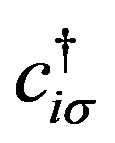 and
and  denote the creation and annihilation operators of electrons, respectively, and
denote the creation and annihilation operators of electrons, respectively, and  is the number operator. The second term represents the on-site Coulomb interaction which acts when the two electrons occupy the same site. The numbers of lattice sites and electrons are denoted as
is the number operator. The second term represents the on-site Coulomb interaction which acts when the two electrons occupy the same site. The numbers of lattice sites and electrons are denoted as  and
and , respectively. The electron density is
, respectively. The electron density is .
.
In the non-interacting limit , the Hamiltonian is easily diagonalized in terms of the Fourier transformation. In the ground state each energy level is occupied by electrons up to the Fermi energy. In the other limit
, the Hamiltonian is easily diagonalized in terms of the Fourier transformation. In the ground state each energy level is occupied by electrons up to the Fermi energy. In the other limit , each site is occupied by the upor down-spin electron, or is empty. The non-zero
, each site is occupied by the upor down-spin electron, or is empty. The non-zero  induces the movement of electrons that leads to a metallic state id
induces the movement of electrons that leads to a metallic state id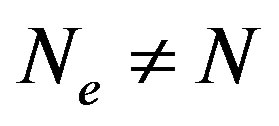 . The ground state is probably insulating at half-filling
. The ground state is probably insulating at half-filling 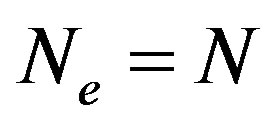 if
if  is sufficiently large.
is sufficiently large.
If  are non-zero only for the nearest-neighbor pairs, the Hubbard Hamiltonian is transformed to the following effective Hamiltonian for large
are non-zero only for the nearest-neighbor pairs, the Hubbard Hamiltonian is transformed to the following effective Hamiltonian for large 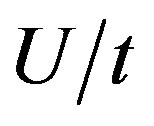 [67]:
[67]:
 (3)
(3)
where  and
and  and
and 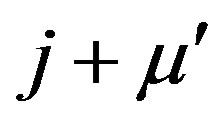 indicate the nearest-neighbor sites in the
indicate the nearest-neighbor sites in the  and
and  directions, respectively. The second term contains the three-site terms when
directions, respectively. The second term contains the three-site terms when . If we neglect the three-site terms, this effective Hamiltonian is reduced to the t-J model:
. If we neglect the three-site terms, this effective Hamiltonian is reduced to the t-J model:

where .
.
The Hubbard model has a long history in describing the magnetism of materials since the early works by Hubbard [26], Gutzwiller [68] and Kanamori [69]. Onedimensional Hubbard model has been well understood by means of the Bethe ansatz [70-72] and conformal field theory [73-75]. The solutions established a novel concept of the Tomonaga-Luttinger liquid [76] which is described by the scalar bosons corresponding to charge and spin sectors, respectively. The correlated electrons in twoand three-dimensional space are still far from a complete understanding in spite of the success for the one-dimensional Hubbard model. A possibility of superconductivity is a hot topic as well as the magnetism and metal-insulator transition for the twoand three-dimensional Hubbard model.
The three-band Hubbard model that contains  and
and  orbitals has also been investigated intensively with respect to high temperature superconductors [24,64, 77-88]. This model is also called the d-p model. The 2D three-band Hubbard model is the more realistic and relevant model for two-dimensional CuO2 planes which are contained usually in the crystal structures of high-
orbitals has also been investigated intensively with respect to high temperature superconductors [24,64, 77-88]. This model is also called the d-p model. The 2D three-band Hubbard model is the more realistic and relevant model for two-dimensional CuO2 planes which are contained usually in the crystal structures of high- superconductors. The network of CuO2 layer is shown in Figure 3. The parameters of the three-band Hubbard model are given by the Coulomb repulsion
superconductors. The network of CuO2 layer is shown in Figure 3. The parameters of the three-band Hubbard model are given by the Coulomb repulsion , energy levels of
, energy levels of  electrons
electrons  and
and  electron
electron , and transfer between
, and transfer between  orbitals given by
orbitals given by . Typical parameter values for the three-band (
. Typical parameter values for the three-band ( -
- ) Hubbard model are shown in Table 1. The Hamiltonian of the
) Hubbard model are shown in Table 1. The Hamiltonian of the

Figure 3. The lattice of the three-band Hubbard model on the CuO2 plane. Small circles denote Cu sites and large ones denote O sites.

Table 1. Typical parameter values for the three-band Hubbard model. Energies are measured in eV.
three-band Hubbard model is written as [24,47,48,80] (see Equation (4)) where  and
and  represent unit vectors along x and y directions, respectively.
represent unit vectors along x and y directions, respectively.  and
and  denote the operators for the
denote the operators for the  electrons at site
electrons at site . Similarly
. Similarly  and
and 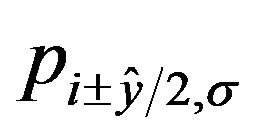 are defined.
are defined. 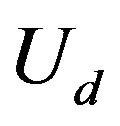 denotes the strength of Coulomb interaction between
denotes the strength of Coulomb interaction between  electrons. For simplicity we neglect the Coulomb interaction among
electrons. For simplicity we neglect the Coulomb interaction among  electrons in this paper. Other notations are standard and energies are measured in
electrons in this paper. Other notations are standard and energies are measured in  units. The number of cells is denoted as
units. The number of cells is denoted as  for the three-band Hubbard model. In the non-interacting case
for the three-band Hubbard model. In the non-interacting case  the Hamiltonian in the k-space is written as (see Equation (5)).
the Hamiltonian in the k-space is written as (see Equation (5)).
where 
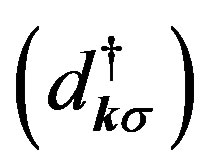 ,
, 
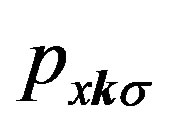 and
and 

are operators for  -,
-,  - and
- and  -electron of the momentum
-electron of the momentum  and spin
and spin , respectively.
, respectively.
In the limit ,
,  , and
, and , the
, the  -
- model is mapped to the t-J model with
model is mapped to the t-J model with
 (6)
(6)
where .
.  gives the antiferromagnetic coupling between the neighboring
gives the antiferromagnetic coupling between the neighboring  and
and  electrons. In real materials
electrons. In real materials 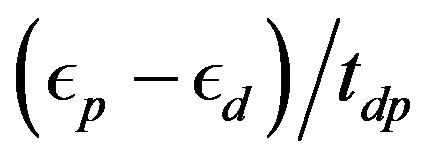 is not so large. Thus it seems that the mapping to the t-J model is not necessarily justified.
is not so large. Thus it seems that the mapping to the t-J model is not necessarily justified.
3. Variational Monte Carlo Studies
In this Section we present studies on the two-dimensional Hubbard model by using the variational Monte Carlo method.
3.1. Variational Monte Carlo Method
Let us start by describing the method based on the 2D Hubbard model. The Hamiltonian is given by
 (7)
(7)
where  denotes summation over all the nearestneighbor bonds and
denotes summation over all the nearestneighbor bonds and 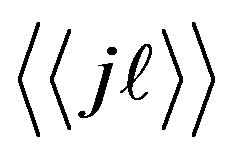 means summation over the next nearest-neighbor pairs.
means summation over the next nearest-neighbor pairs.  is our energy unit. The dispersion is given by
is our energy unit. The dispersion is given by
 (8)
(8)
Our trial wave function is the Gutzwiller-projected wave functions defined as
 (9)
(9)
 (10)
(10)
|  (4) (4)  (5) (5) |
where
 (11)
(11)
 (12)
(12)
 is the Gutzwiller projection operator given by
is the Gutzwiller projection operator given by
 (13)
(13)
 is a variational parameter in the range from 0 to unity and
is a variational parameter in the range from 0 to unity and  labels a site in the real space.
labels a site in the real space. 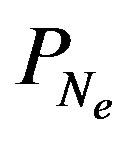 is a projection operator which extracts only the sites with a fixed total electron number
is a projection operator which extracts only the sites with a fixed total electron number . Coefficients
. Coefficients  and
and  in
in  appear in the ratio defined by
appear in the ratio defined by
 (14)
(14)
where  and
and  is a k-dependent gap function.
is a k-dependent gap function.  is a variational parameter working like the chemical potential.
is a variational parameter working like the chemical potential.  is the Fourier transform of
is the Fourier transform of . The wave functions
. The wave functions  and
and  are expressed by the Slater determinants for which the expectations values are evaluated using a Monte Carlo procedure [43,44,92].
are expressed by the Slater determinants for which the expectations values are evaluated using a Monte Carlo procedure [43,44,92]. 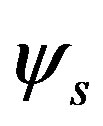 is written as
is written as
 (15)
(15)
where
 (16)
(16)
Then  is written using the Slater determinants as
is written using the Slater determinants as
 (17)
(17)
where  is the Slater determinant defined by
is the Slater determinant defined by
 (18)
(18)
In the process of Monte Carlo procedure the values of cofactors of the matrix in Equation (18) are stored and corrected at each time when the electron distribution is modified. We optimized the ground state energy
 (19)
(19)
with respect to ,
,  and
and  for
for  for
for . For
. For 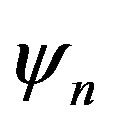 the variational parameter is only
the variational parameter is only . We can employ the correlated measurements method [93] in the process of searching optimal parameter values minimizing
. We can employ the correlated measurements method [93] in the process of searching optimal parameter values minimizing .
.
A Monte Carlo algorithm developed in the auxiliary field quantum Monte Carlo calculations can also be employed in evaluating the expectation values for the wave functions shown above [94-96]. Note that the Gutzwiller projection operator is written as
 (20)
(20)
where . Then using the discrete HubbardStratonovich transformation, the Gutzwiller operator is the bilinear form:
. Then using the discrete HubbardStratonovich transformation, the Gutzwiller operator is the bilinear form:
 (21)
(21)
where . The Hubbard-Stratonovich auxiliary field
. The Hubbard-Stratonovich auxiliary field  takes the values of
takes the values of . The norm
. The norm  is written as
is written as
 (22)
(22)
where  is a diagonal
is a diagonal  matrix corresponding to the potential
matrix corresponding to the potential
 (23)
(23)
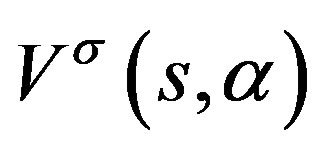 is written as
is written as
 (24)
(24)
where  denotes a diagonal matrix with elements given by the arguments
denotes a diagonal matrix with elements given by the arguments . The elements of
. The elements of 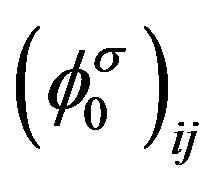
 are given by linear combinations of plane waves. For example,
are given by linear combinations of plane waves. For example,
 (25)
(25)
Then we can apply the standard Monte Carlo sampling method to evaluate the expectation values [94,95]. This method is used to consider an off-diagonal Jastrow correlation factor of exp(–S)-type. The results for the improved wave functions are discussed in Section 3.10.
3.2. Superconducting Condensation Energy
We study the cases of the  -, extended
-, extended  - (
- ( -) and
-) and  -wave gap functions in the following:
-wave gap functions in the following:
 (26)
(26)
 (27)
(27)
 (28)
(28)
In Figure 4 calculated energies per site with  on the
on the  lattice are shown for the case of
lattice are shown for the case of  and
and  [46].
[46]. 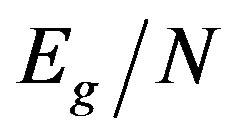 is plotted as a function of
is plotted as a function of  for three types of gap functions shown above. We impose the periodic and the antiperiodic boundary conditions for
for three types of gap functions shown above. We impose the periodic and the antiperiodic boundary conditions for  - and
- and  -direction, respectively. This set of boundary conditions is chosen so that
-direction, respectively. This set of boundary conditions is chosen so that  does not vanish for any k-points occupied by electrons.
does not vanish for any k-points occupied by electrons.  was obtained as the average of the results of several Monte Carlo calculations each with
was obtained as the average of the results of several Monte Carlo calculations each with  steps.
steps.  has minimum at a finite value of
has minimum at a finite value of  in the case of the d-wave gap function.
in the case of the d-wave gap function.
The energy gain 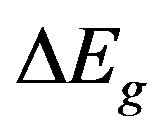 in the superconducting state is called the SC condensation energy in this paper.
in the superconducting state is called the SC condensation energy in this paper.  is plotted as a function of
is plotted as a function of  in Figure 5 in order to examine the size dependence of the SC energy gain [97]. Lattice sizes treated are from
in Figure 5 in order to examine the size dependence of the SC energy gain [97]. Lattice sizes treated are from 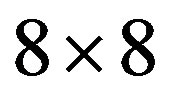 to
to . The electron density
. The electron density  is in the range of
is in the range of . Other parameters are
. Other parameters are  and
and 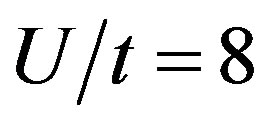 in
in  units. Bulk limit
units. Bulk limit  of SC condensation energy
of SC condensation energy  was obtained by plotting as a function of
was obtained by plotting as a function of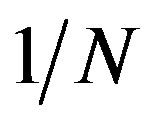 . The linear fitting line indicates very
. The linear fitting line indicates very

Figure 5. Energy gain per site in the SC state with reference to the normal state for the 2D Hubbard model is plotted as a function of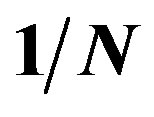 . L is the length of the edge of the square lattice. YBCO attached to the vertical axis indicates the experimental value of the SC condensation energy for YBa2Cu3O4 [97].
. L is the length of the edge of the square lattice. YBCO attached to the vertical axis indicates the experimental value of the SC condensation energy for YBa2Cu3O4 [97].
clearly that the bulk limit remains finite when  and
and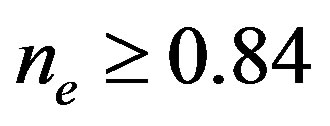 . When
. When ,
,  and
and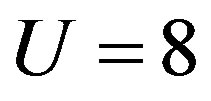 , the bulk-limit
, the bulk-limit  is
is , where t = 0.51 eV is used [98]. Thus the superconductivity is a real bulk property, not a spurious size effect. The value is remarkably close to experimental values 0.17 ~ 0.26 meV/site estimated from specific heat data [99,100] and 0.26 meV/site from the critical magnetic field
, where t = 0.51 eV is used [98]. Thus the superconductivity is a real bulk property, not a spurious size effect. The value is remarkably close to experimental values 0.17 ~ 0.26 meV/site estimated from specific heat data [99,100] and 0.26 meV/site from the critical magnetic field 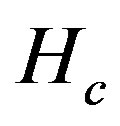 [101] for optimally doped YBa2Cu3O4 (YBCO). This good agreement strongly indicates that the 2D Hubbard model includes essential ingredients for the superconductivity in the cuprates.
[101] for optimally doped YBa2Cu3O4 (YBCO). This good agreement strongly indicates that the 2D Hubbard model includes essential ingredients for the superconductivity in the cuprates.
We just point out that the t-J model gives  at
at  for J = 4 t2/U = 0.5 and
for J = 4 t2/U = 0.5 and  [102]. This value is 50 times larger than the experimental values indicating a serious quantitative problem with this model. This means that the t-J model made from the leading two terms in the expansion in terms of
[102]. This value is 50 times larger than the experimental values indicating a serious quantitative problem with this model. This means that the t-J model made from the leading two terms in the expansion in terms of 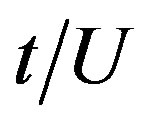 of the canonical transformation of the Hubbard model should be treated with the higher-order terms in order to give a realistic SC condensation energy.
of the canonical transformation of the Hubbard model should be treated with the higher-order terms in order to give a realistic SC condensation energy.
Here we show the SC condensation energy as a function of  in Figure 6. The condensation energy
in Figure 6. The condensation energy  is increased as
is increased as  is increased as far as
is increased as far as . In the strong coupling region
. In the strong coupling region , we obtain the large condensation energy.
, we obtain the large condensation energy.
3.3. Fermi Surface and Condensation Energy
Now let us consider the relationship between the Fermi surface structure and the strength of superconductivity. The experimental SC condensation energy for (La,Sr)2CuO4 (LSCO) is estimated at 0.029 meV/(Cu site) or 0.00008 in units of t which is much smaller than that

Figure 6. Energy gain per site in the SC state with reference to the normal state for the 2D Hubbard model as a function of the Coulomb repulsion U. The system is 10 × 10 with the electron number 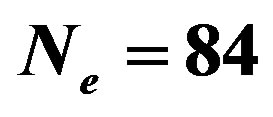 and
and .
.
for YBCO. [103] The band parameter values of LSCO were estimated as  and
and  [104]. This set corresponds roughly to
[104]. This set corresponds roughly to . The latter value is much larger than the above-mentioned experimental value for LSCO. However, the stripe-type SDW state coexists with superconductivity [105,106] and the SC part of the whole
. The latter value is much larger than the above-mentioned experimental value for LSCO. However, the stripe-type SDW state coexists with superconductivity [105,106] and the SC part of the whole  is much reduced. Therefore, such a coexistence allows us to qualitatively understand the SC
is much reduced. Therefore, such a coexistence allows us to qualitatively understand the SC  in LSCO.
in LSCO.
On the other hand, Tl2201  and Hg1201
and Hg1201 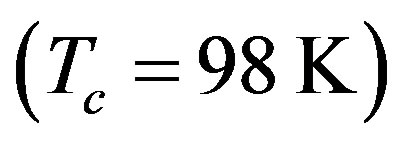 band calculations by Singh and Pickett [107] give very much deformed Fermi surfaces that can be fitted by large
band calculations by Singh and Pickett [107] give very much deformed Fermi surfaces that can be fitted by large  such as
such as . For Tl2201, an Angular Magnetoresistance Oscillations (AMRO) work [108] gives information of the Fermi surface, which allows to get
. For Tl2201, an Angular Magnetoresistance Oscillations (AMRO) work [108] gives information of the Fermi surface, which allows to get  and
and . There is also an Angle-Resolved Photoemission Study (ARPES) [109], which provides similar values. In the case of Hg1201, there is an ARPES work [110], form which we obtain by fitting
. There is also an Angle-Resolved Photoemission Study (ARPES) [109], which provides similar values. In the case of Hg1201, there is an ARPES work [110], form which we obtain by fitting  and
and . For such a deformed Fermi surface,
. For such a deformed Fermi surface,  in the bulk limit is reduced considerably. [111,112] Therefore, the SC
in the bulk limit is reduced considerably. [111,112] Therefore, the SC  calculated by VMC indicates that the Fermi surface of LSCO-type is more favorable for high
calculated by VMC indicates that the Fermi surface of LSCO-type is more favorable for high . The lower
. The lower  in LSCO may be attributed to the coexistence with antiferromagnetism of stripe type.
in LSCO may be attributed to the coexistence with antiferromagnetism of stripe type.
3.4. Ladder Hubbard Model
The SC condensation energy in the bulk limit for the ladder Hubbard model has also been evaluated using the variational Monte Carlo method [54]. The Hamiltonian is given by the 1D two-chain Hubbard model: [51,52,55, 56,85,113-116]
 (29)
(29)
where 
 is the creation (annihilation) operator of an electron with spin
is the creation (annihilation) operator of an electron with spin  at the
at the  th site along the
th site along the  th chain
th chain .
.  is the intrachain nearest-neighbor transfer and
is the intrachain nearest-neighbor transfer and  is the interchain nearest-neighbor transfer energy. The energy is measured in
is the interchain nearest-neighbor transfer energy. The energy is measured in  units. The energy minimum was given when the components of the gap function
units. The energy minimum was given when the components of the gap function  take finite values plotted in Figure 7 for the lattice of
take finite values plotted in Figure 7 for the lattice of  sites with 34 electrons imposing the periodic boundary condition [54]. Each component of
sites with 34 electrons imposing the periodic boundary condition [54]. Each component of  was optimized for
was optimized for  and
and . There are two characteristic features; one is that the components of the bonding and antibonding bands have opposite signs each other and second is that the absolute values of
. There are two characteristic features; one is that the components of the bonding and antibonding bands have opposite signs each other and second is that the absolute values of 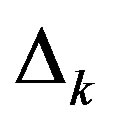 of the antibonding band
of the antibonding band  is much larger than that of the bonding band
is much larger than that of the bonding band
 . In order to reduce the computation cpu time,
. In order to reduce the computation cpu time,
 of each band was forced to take a fixed value specific to each band, i.e.
of each band was forced to take a fixed value specific to each band, i.e.  for the bonding band and
for the bonding band and 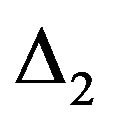 for the antibonding band. This drastically reduces the number of the variational parameters but still allows us to get a substantial value of the condensation energy.
for the antibonding band. This drastically reduces the number of the variational parameters but still allows us to get a substantial value of the condensation energy.  and
and  take opposite sign, which is similar to that of the
take opposite sign, which is similar to that of the  gap function.
gap function.
The energy gain 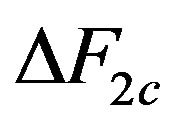 remains finite in the bulk limit when
remains finite in the bulk limit when . The SC condensation energy per site in the bulk limit is plotted as a function of
. The SC condensation energy per site in the bulk limit is plotted as a function of  in Figure 8 [54]. The SC region derived from the SC condensation energy in the bulk limit is consistent with the results obtained from the density-matrix renormalization group [55,56] and the exact-diagonalization method [51,52,115]. The maximum value of
in Figure 8 [54]. The SC region derived from the SC condensation energy in the bulk limit is consistent with the results obtained from the density-matrix renormalization group [55,56] and the exact-diagonalization method [51,52,115]. The maximum value of  is 0.0008 which is of the same order of magnitude as the maximum condensation energy obtained for the 2D Hubbard model [46].
is 0.0008 which is of the same order of magnitude as the maximum condensation energy obtained for the 2D Hubbard model [46].
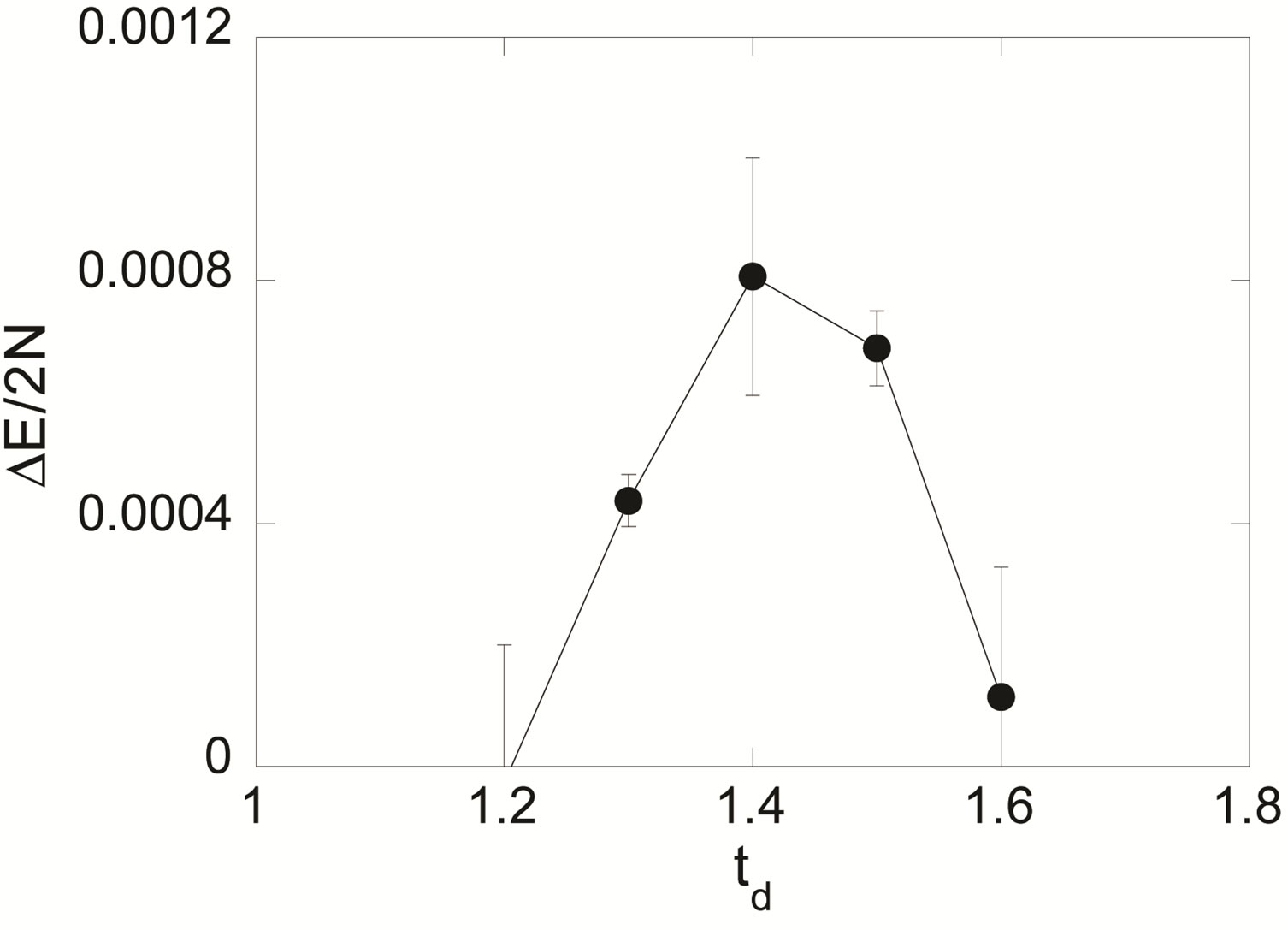
Figure 8.  dependence of the SC condensation energy
dependence of the SC condensation energy  for the two-chain Hubbard model in the bulk limit [54].
for the two-chain Hubbard model in the bulk limit [54].
3.5. Condensation Energy in the d-p Model
The SC energy gain for the d-p model, namely, threeband Hubbard model in Equation (4) has also been evaluated using the variational Monte Carlo method. For the three-band model the wave functions are written as
 (30)
(30)
 (31)
(31)
where  is the linear combination of
is the linear combination of ,
,  and
and 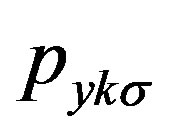 constructed to express the operator for the lowest band (in the hole picture) or the highest band (in the electron picture) of the non-interacting Hamiltonian. The numerical calculations have been done in the hole picture. The Gutzwiller parameter
constructed to express the operator for the lowest band (in the hole picture) or the highest band (in the electron picture) of the non-interacting Hamiltonian. The numerical calculations have been done in the hole picture. The Gutzwiller parameter , effective level difference
, effective level difference , chemical potential
, chemical potential  and superconducting order parameter
and superconducting order parameter  are the variational parameters.
are the variational parameters.
The similar results to the single-band Hubbard model were obtained as shown in Figure 9 for ,
,  and
and  in
in  units where the calculations were performed in the hole picture [24]. The SC condensation energy for the three-band model is
units where the calculations were performed in the hole picture [24]. The SC condensation energy for the three-band model is  meV per site in the optimally doped region. We set
meV per site in the optimally doped region. We set  as estimated in Table 1. There is a tendency that
as estimated in Table 1. There is a tendency that  increases as
increases as  increases which is plotted in Figure 10. This tendency is not, however, in accordance with NQR (nuclear quadrupole resonance) study on cuprates. [117] We think that the NQR experiments indicate an importance of the Coulomb interaction on oxygen sites. This will be discussed in Section 3.11.
increases which is plotted in Figure 10. This tendency is not, however, in accordance with NQR (nuclear quadrupole resonance) study on cuprates. [117] We think that the NQR experiments indicate an importance of the Coulomb interaction on oxygen sites. This will be discussed in Section 3.11.
3.6. Antiferromagnetic State
When the density of doped holes is zero or small, the 2D single-band or three-band Hubbard model takes an antiferromganetic state as its ground state. The magnetic
order is destroyed and superconductivity appears with the increase of doped hole density. The transition between the d-wave SC and the uniform SDW states has been investigated by computing the energy of the SDW state by using the variational Monte Carlo method. The trial SDW wave function is written as
 (32)
(32)
 (33)
(33)
 (34)
(34)
 (35)
(35)
 (36)
(36)
Summation over  and
and  in Equation (33) is performed over the filled k-points, as in the calculation of the normal state energy.
in Equation (33) is performed over the filled k-points, as in the calculation of the normal state energy.  is the SDW wave vector given by
is the SDW wave vector given by  and
and  is the SDW potential amplitude.
is the SDW potential amplitude.
As shown in Figure 11, the energy gain per site in the SDW state rises very sharply from 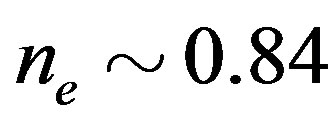 for
for  [46]. At
[46]. At  it is slightly larger than that in the SC state, and at
it is slightly larger than that in the SC state, and at  there is no more stable SDW state. Thus the boundary between the SDW and the SC states is given at
there is no more stable SDW state. Thus the boundary between the SDW and the SC states is given at . The results of the bulk limit calculations indicate that the energy gain in the SC state at
. The results of the bulk limit calculations indicate that the energy gain in the SC state at  takes the extremely small value and the value at
takes the extremely small value and the value at 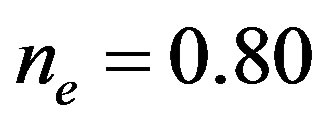 vanishes as
vanishes as . Hence the pure d-wave SC state possibly exists near the boundary at
. Hence the pure d-wave SC state possibly exists near the boundary at , but the region of pure SC state is very restricted.
, but the region of pure SC state is very restricted.
Let us turn to the three-band model. We show the antiferromagnetic-paramagnetic boundary for  and
and  in the plane of
in the plane of  and the hole density in Figure 12 where AF denotes the antiferromagnetic region [47]. The value
and the hole density in Figure 12 where AF denotes the antiferromagnetic region [47]. The value 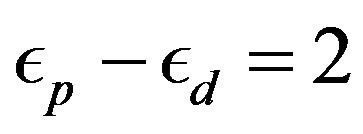 is taken from the estimations by cluster calculations [89-91]. The phase boundary in the region of small
is taken from the estimations by cluster calculations [89-91]. The phase boundary in the region of small  is drawn from an extrapolation. For the intermediate values of
is drawn from an extrapolation. For the intermediate values of ,
,
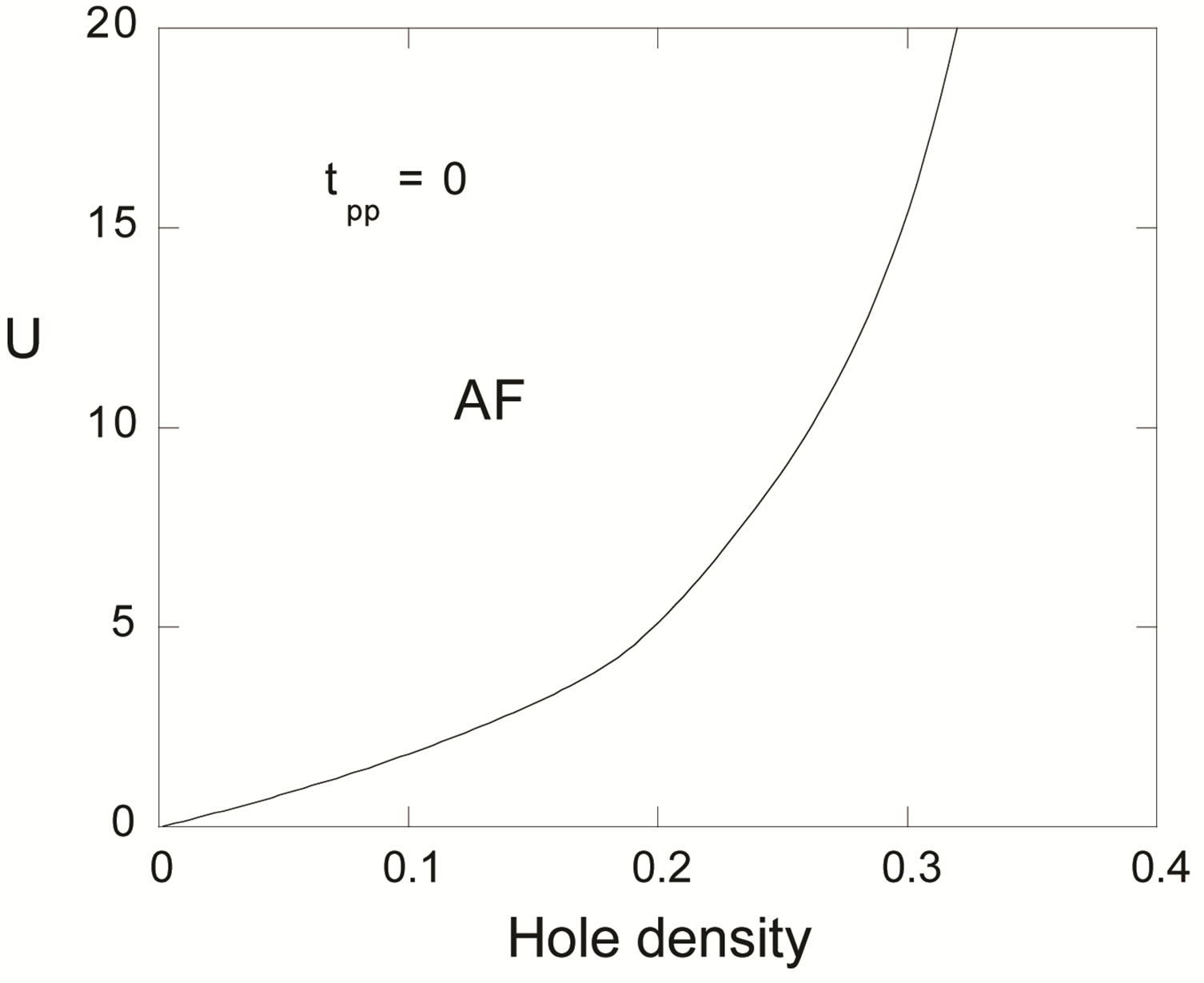
Figure 12. Antiferromagnetic region in the plane of U and the hole density for  and
and .
.
the antiferromagnetic long-range ordering exists up to about 20 percent doping. Thus the similar features are observed compared to the single-band Hubbard model.
Since the three-band Hubbard model contains several parameters, we must examine the parameter dependence of the energy of SDW state. The energy gain 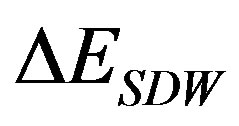 in the SDW state is shown in Figure 13 as a function of doping ratio for several values of
in the SDW state is shown in Figure 13 as a function of doping ratio for several values of .
. 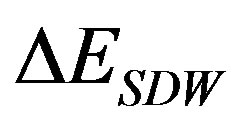 increases as
increases as  increases as expected. In Figure 14
increases as expected. In Figure 14  - and
- and  -dependencies of
-dependencies of  are presented. The SDW phase extends up to 30 percent doping when
are presented. The SDW phase extends up to 30 percent doping when 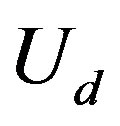 is large. It follows from the calculations that the SDW region will be reduced if
is large. It follows from the calculations that the SDW region will be reduced if  and
and  decrease.
decrease.
From the calculations for the SDW wave functions, we should set  and
and  small so that the SDW phase does not occupy a huge region near half-filling. In Figures 15 and 16, we show energy gains for both the SDW and SC states for
small so that the SDW phase does not occupy a huge region near half-filling. In Figures 15 and 16, we show energy gains for both the SDW and SC states for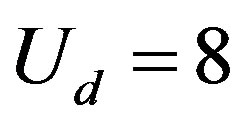 ,
,  ,
, 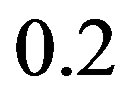 and
and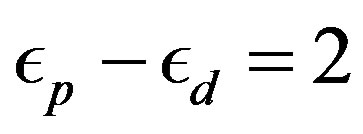 , where the right hand side and left hand side indicate the hole-doped and electron-doped case, respectively. Solid symbols indicate the results for
, where the right hand side and left hand side indicate the hole-doped and electron-doped case, respectively. Solid symbols indicate the results for  and open symbols for
and open symbols for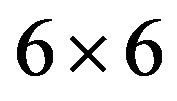 . For this set of parameters the SDW region extends up to 20 percent doping and the pure d-wave phase exists outside of the SDW phase. The d-wave phase may be possibly identified with superconducting phase in the overdoped region in the high-
. For this set of parameters the SDW region extends up to 20 percent doping and the pure d-wave phase exists outside of the SDW phase. The d-wave phase may be possibly identified with superconducting phase in the overdoped region in the high- superconductors.
superconductors.
3.7. Stripes and Its Coexistence with Superconductivity
Incommensurate magnetic and charge peaks have been observed from the elastic neutron-scattering experiments in the underdoped region of the Nd-doped La2–x–yNdySrxCuO4 [118] (Figure 17). Recent neutron experiments have also revealed the incommensurate spin structures [119-123]. Rapid decrease of the Hall resistivity in this region suggests that the electric con-
duction is approximately one dimensional [124]. The angle-resolved photo-emission spectroscopy measurements also suggested a formation of two sets of onedimensional Fermi surface [125]. Then it has been proposed that these results might be understood in the framework of the stripe state where holes are doped in the domain wall between the undoped spin-density-wave
domains. This state is a kind of incommensurate SDW state. It was also shown that the incommensurability is proportional to the hole density in the low-doping region in which the hole number per stripe is half of the site number along one stripe [118,120]. A static magnetically ordered phase has been observed by  SR over a wide range of SC phase for
SR over a wide range of SC phase for  in La2–xSrxCuO4 (LSCO) [126]. Thus the possibility of superconductivity that occurs in the stripe state is a subject of great interest [127-130]. The incommensurate magnetic scattering spots around
in La2–xSrxCuO4 (LSCO) [126]. Thus the possibility of superconductivity that occurs in the stripe state is a subject of great interest [127-130]. The incommensurate magnetic scattering spots around  were observed in the SC phase in the range of
were observed in the SC phase in the range of  in the elastic and inelastic neutron-scattering experiments with LSCO [127,128,130]. The hole dependence of the incommensurability and the configuration of the spots around the Bragg spot in the SC phase indicated the vertical stripe. The neutronscattering experiments have also revealed that a diagonal spin modulation occurs across the insulating spin-glass phase in La2–xSrxCuO4 for
in the elastic and inelastic neutron-scattering experiments with LSCO [127,128,130]. The hole dependence of the incommensurability and the configuration of the spots around the Bragg spot in the SC phase indicated the vertical stripe. The neutronscattering experiments have also revealed that a diagonal spin modulation occurs across the insulating spin-glass phase in La2–xSrxCuO4 for , where a one-dimensional modulation is rotated by 45 degrees from the stripe in the SC phase. The incommensurability
, where a one-dimensional modulation is rotated by 45 degrees from the stripe in the SC phase. The incommensurability  versus hole density is shown in Figure 18 schematically [129,130]. The diagonal stripe changes into the vertical stripe across the boundary between the insulating and SC phase.
versus hole density is shown in Figure 18 schematically [129,130]. The diagonal stripe changes into the vertical stripe across the boundary between the insulating and SC phase.
Let us investigate the doped system from the point of modulated spin structures [131-141]. The stripe SDW state has been studied theoretically by using the meanfiled theory [132-136]. They found that the stripe state appears when an incommensurate nesting becomes

Figure 17. Charge and spin density as a function of the distance for a striped state [50].

Figure 18. Schematic illustration of the incommensurability versus hole density.
favorable in the hole-doped 2D Hubbard model. When the electron correlation correlation is strong or intermediate, it was shown that the stripe state is more stable than the commensurate spin-density-wave state with the wave vector  in the ground state of the 2D Hubbard model by using the variational Monte Carlo method [131]. It has also been confirmed by the same means that the stripe states are stabilized in the d-p model [48]. The purpose of this section is to examine whether the superconductivity can coexist with static stripes in the 2D Hubbard model in a wider doping region and investigate the doping dependence of the coexisting state.
in the ground state of the 2D Hubbard model by using the variational Monte Carlo method [131]. It has also been confirmed by the same means that the stripe states are stabilized in the d-p model [48]. The purpose of this section is to examine whether the superconductivity can coexist with static stripes in the 2D Hubbard model in a wider doping region and investigate the doping dependence of the coexisting state.
We consider the 2D Hubbard model on a square lattice. We calculate the variational energy in the coexistent state that is defined by
 (37)
(37)
where 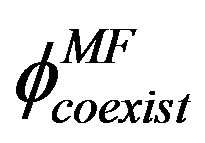 is a mean-field wave function. The effective mean-field Hamiltonian for the coexisting state is [105] represented by
is a mean-field wave function. The effective mean-field Hamiltonian for the coexisting state is [105] represented by
 (38)
(38)
where the diagonal terms describe the incommensurate spin-density wave state:
 (39)
(39)
where  is the chemical potential. The vertical stripe state is represented by the charge density
is the chemical potential. The vertical stripe state is represented by the charge density  and the spin density
and the spin density  that are spatially modulated as
that are spatially modulated as
 (40)
(40)
 (41)
(41)
where  denotes the position of vertical stripes. The amplitude
denotes the position of vertical stripes. The amplitude  is fixed by
is fixed by . The off-diagonal terms in Equation (38) are defined in terms of the d-wave SC gap as
. The off-diagonal terms in Equation (38) are defined in terms of the d-wave SC gap as
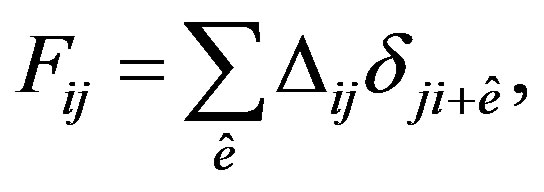 (42)
(42)
where ,
,  (unit vectors). We consider two types of the spatially inhomogeneous superconductivity: anti-phase and in-phase defined as
(unit vectors). We consider two types of the spatially inhomogeneous superconductivity: anti-phase and in-phase defined as
 (43)
(43)
 (44)
(44)
and
 (45)
(45)
 (46)
(46)
respectively. Here,  and
and  is a incommensurability given by the stripe’s periodicity in the y direction with regard to the spin. The anti-phase (inphase) means that the sign if the superconducting gap is (is not) changed between nearest domain walls.
is a incommensurability given by the stripe’s periodicity in the y direction with regard to the spin. The anti-phase (inphase) means that the sign if the superconducting gap is (is not) changed between nearest domain walls.
The wave function  is made from the solution of the Bogoliubov-de Gennes equation represented by
is made from the solution of the Bogoliubov-de Gennes equation represented by
 (47)
(47)
 (48)
(48)
The Bogoliubov quasiparticle operators are written in the form
 (49)
(49)
 (50)
(50)
Then the coexistence wave function is written as [105,142]
 (51)
(51)
for constants  and
and . The calculations are performed for the wave function
. The calculations are performed for the wave function . The variational parameters are
. The variational parameters are ,
,  ,
,  ,
,  and
and . The system parameters were chosen as
. The system parameters were chosen as  and
and  suitable for cuprate superconductors. It has been shown that the “anti-phase” configuration is more stable than the “in-phase” one [105].
suitable for cuprate superconductors. It has been shown that the “anti-phase” configuration is more stable than the “in-phase” one [105].
Here, the system parameters are  and
and . We use the periodic boundary condition in the x-direction and anti-periodic one in the y-direction. In Figure 19, we show the total energy of the coexistent state,
. We use the periodic boundary condition in the x-direction and anti-periodic one in the y-direction. In Figure 19, we show the total energy of the coexistent state,  , as a function of the SC gap
, as a function of the SC gap  for the cases of anti-phase and in-phase. The SC condensation energy
for the cases of anti-phase and in-phase. The SC condensation energy  is estimated as 0.0008 t per site at the hole density 0.125 on the
is estimated as 0.0008 t per site at the hole density 0.125 on the  lattice with periodic boundary condition in x-direction and antiperiodic one in y-direction.
lattice with periodic boundary condition in x-direction and antiperiodic one in y-direction.  in the coexistence state is defined as the decrease of energy due to finite
in the coexistence state is defined as the decrease of energy due to finite . If we use
. If we use , this is evaluated as
, this is evaluated as . The SC condensation energy per site is shown as a function of hole density in Figure 20. One finds that
. The SC condensation energy per site is shown as a function of hole density in Figure 20. One finds that  in the stripe state decreases as the hole density decreases. This tendency is reasonable since the SC order is weakened in the domain of the incommensurate SDW because of the vanishingly small carrier concentration contributing the superconductivity in this domain. This behavior is consistent with the SC condensation energy estimated from the specific heat measurements [143].
in the stripe state decreases as the hole density decreases. This tendency is reasonable since the SC order is weakened in the domain of the incommensurate SDW because of the vanishingly small carrier concentration contributing the superconductivity in this domain. This behavior is consistent with the SC condensation energy estimated from the specific heat measurements [143].
There is a large renormalization of the Fermi surface due to the correlation effect in the striped state [144]. We considered the next-nearest transfer  in the trial function as a variational parameter
in the trial function as a variational parameter . In Figure 21,
. In Figure 21,
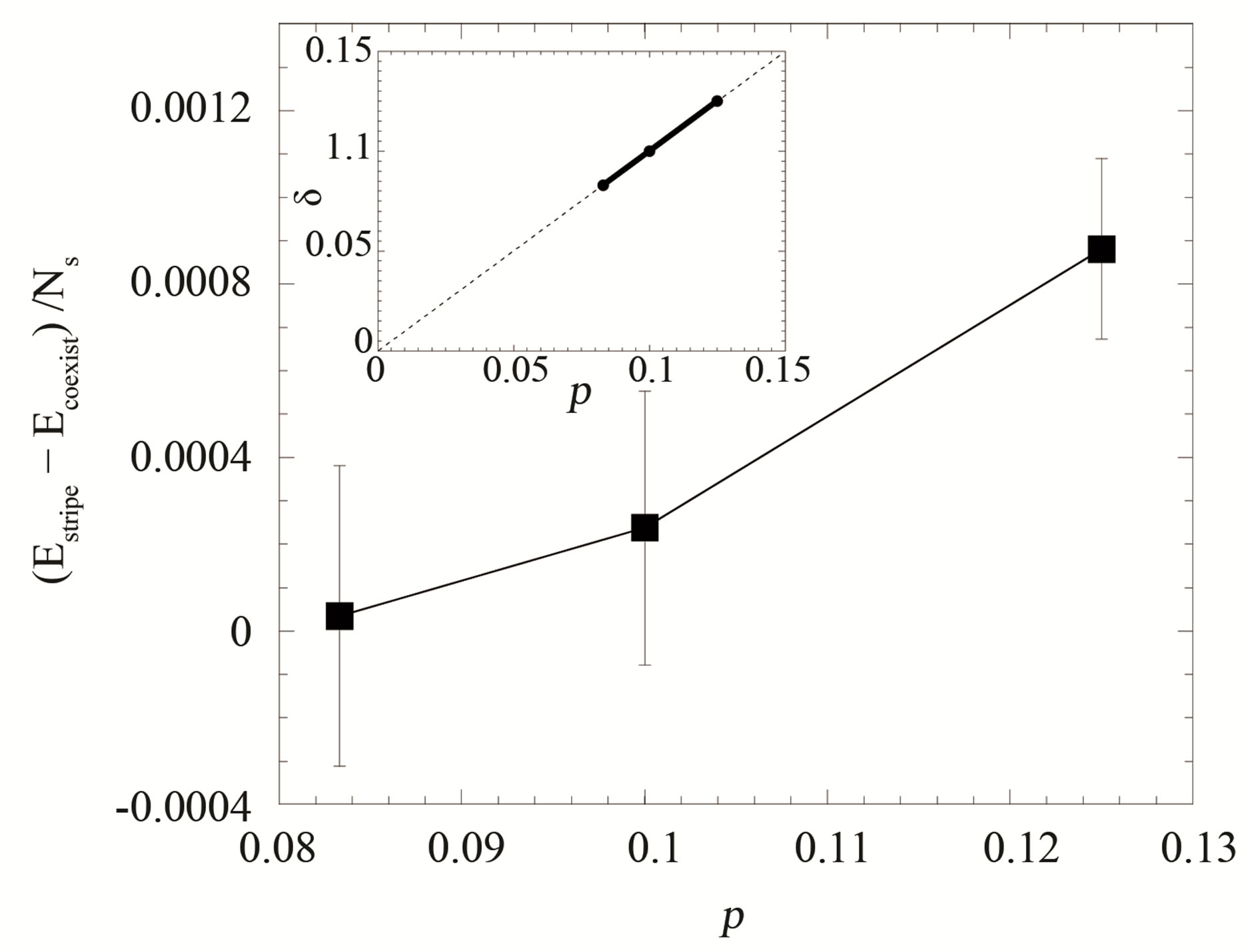
Figure 20. Superconducting condensation energy per site in the coexistence state as a function of the hole density , 0.10 and 0.125. The model is the single-band Hubbard Hamiltonian with
, 0.10 and 0.125. The model is the single-band Hubbard Hamiltonian with . The stripe interval is preserved constant. The inset shows the hole dependence of the incommensurability in the coexistent state [105].
. The stripe interval is preserved constant. The inset shows the hole dependence of the incommensurability in the coexistent state [105].
optimized values of  for the striped state are shown as a function of
for the striped state are shown as a function of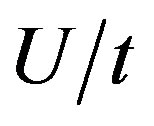 . The
. The  increases as
increases as  increases. We also mention that the optimized
increases. We also mention that the optimized  almost vanishes. The renormalized Fermi surface of
almost vanishes. The renormalized Fermi surface of ,
, 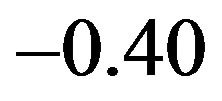 and
and  are plotted in Figure 22. The system is a
are plotted in Figure 22. The system is a  lattice with
lattice with  and the electron density 0.875. As
and the electron density 0.875. As  is incresed, the Fermi surface is more deformed. We show the the gradient of the momentum distribution function,
is incresed, the Fermi surface is more deformed. We show the the gradient of the momentum distribution function,  , calculated in the optimized stripe state in Figure 23. The brighter areas coincide with the renormalized Fermi surface with
, calculated in the optimized stripe state in Figure 23. The brighter areas coincide with the renormalized Fermi surface with  and
and  for
for .
.
The calculations for the three-band Hubbard model has also been done taking into account the coexistence of stripes and SC [15,106]. The energy of antiferromagnetic state would be lowered further if we consider the incommensurate spin correlation in the wave function. The phase diagram in Figure 24 presents the region of stable AF phase in the plane of  and
and . For large
. For large , we have the region of the AF state with an eight-lattice periodicity in accordance with the results of neutron-scattering measurements [118,123]. The energy at
, we have the region of the AF state with an eight-lattice periodicity in accordance with the results of neutron-scattering measurements [118,123]. The energy at  is shown in Figure 25 where the 4-lattice stripe state has higher energy than that for 8-lattice stripe for all the values of
is shown in Figure 25 where the 4-lattice stripe state has higher energy than that for 8-lattice stripe for all the values of .
.
The Bogoliubov-de Gennes equation is extended to the case of three orbitals ,
,  and
and .
.  and
and  are now
are now  matrices. The energy of the state with double order parameters
matrices. The energy of the state with double order parameters  and
and  is shown in Figure 26 on the
is shown in Figure 26 on the  lattice at the doping rate 1/8. The SC condensation energy per site is evaluated as
lattice at the doping rate 1/8. The SC condensation energy per site is evaluated as  for
for ,
,  and
and . If we use
. If we use  [89-91], we obtain
[89-91], we obtain 
 which is slightly smaller than and close to the value obtained for the single-band Hubbard model. We show the size dependence of the SC condensation
which is slightly smaller than and close to the value obtained for the single-band Hubbard model. We show the size dependence of the SC condensation
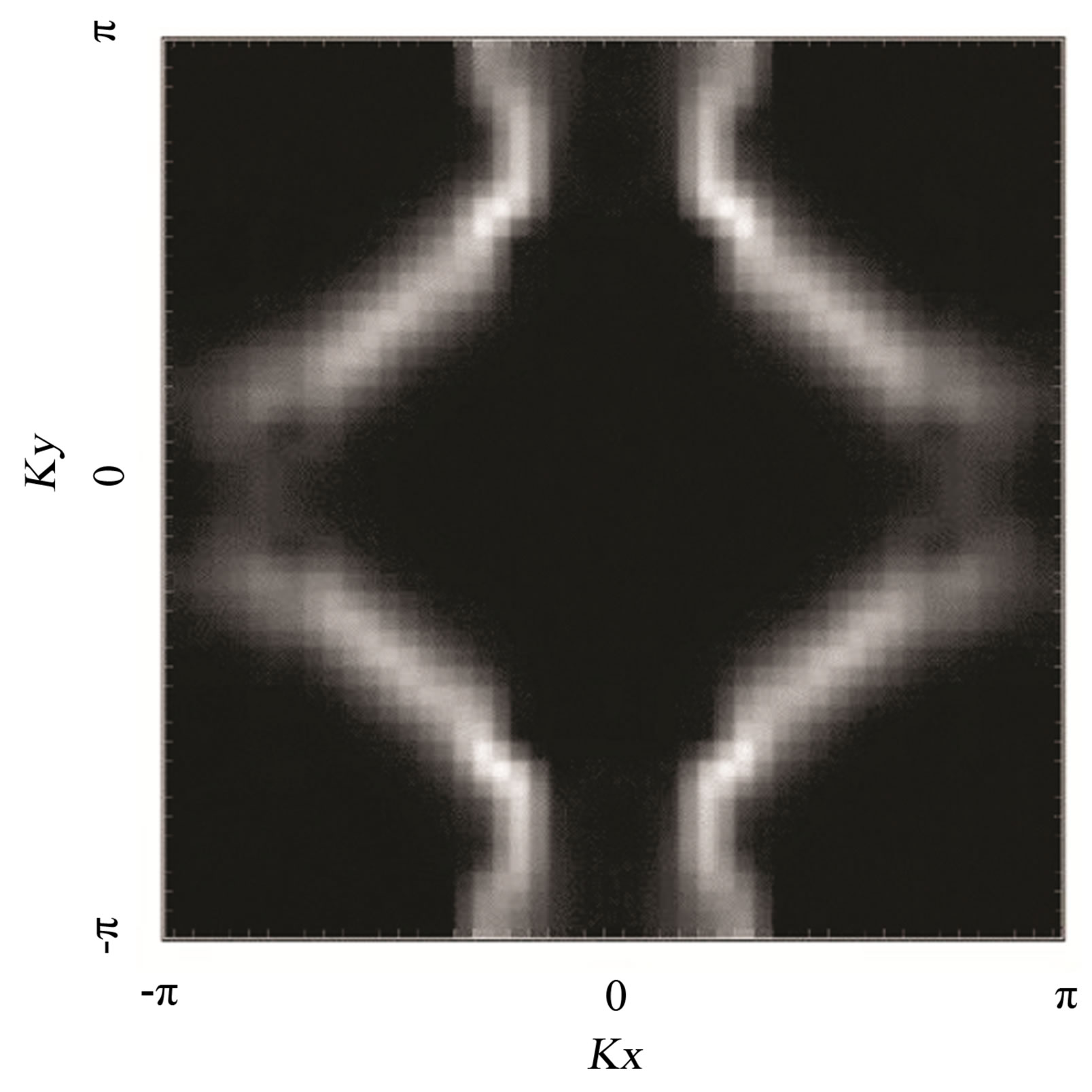
Figure 23. Contour plot of  measured for the projected stripe state on 24 × 24 lattice with
measured for the projected stripe state on 24 × 24 lattice with . The electron density is 0.875.
. The electron density is 0.875.

Figure 24. Phase diagram of stable antiferromagnetic state in the plane of  and
and  obtained for 16 × 4 lattice.
obtained for 16 × 4 lattice.

Figure 25. Energy as a function of  for 16 × 16 square lattice at
for 16 × 16 square lattice at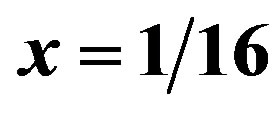 . Circles, triangles and squares denote the energy for 4-lattice stripes, 8-lattice stripes, and commensurate SDW, respectively, where n-lattice stripe is the incommensurate state with one stripe per n ladders. The boundary conditions are antiperiodic in x-direction and periodic in y-direction [47,106].
. Circles, triangles and squares denote the energy for 4-lattice stripes, 8-lattice stripes, and commensurate SDW, respectively, where n-lattice stripe is the incommensurate state with one stripe per n ladders. The boundary conditions are antiperiodic in x-direction and periodic in y-direction [47,106].
energy for , 0.125 0.08333 and 0.0625 in Figure 27. We set the parameters as
, 0.125 0.08333 and 0.0625 in Figure 27. We set the parameters as  and
and  in
in 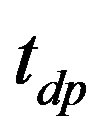 units, which is reasonable from the viewpoint of the density of states and is remarkably in accordance with cluster estimations [89-91], and also in the region of eight-lattice periodicity at
units, which is reasonable from the viewpoint of the density of states and is remarkably in accordance with cluster estimations [89-91], and also in the region of eight-lattice periodicity at . We have carried out the Monte Carlo calculations up to
. We have carried out the Monte Carlo calculations up to  sites (768 atoms in total). In the overdoped region in the range of
sites (768 atoms in total). In the overdoped region in the range of , we have the uniform d-wave pairing state as the ground state. The periodicity of spatial variation increases as the doping rate
, we have the uniform d-wave pairing state as the ground state. The periodicity of spatial variation increases as the doping rate  decreases proportional to
decreases proportional to . In the figure we have the 12-lattice periodicity at
. In the figure we have the 12-lattice periodicity at  and 16-lattice periodicity at
and 16-lattice periodicity at . For
. For , 0.125 and 0.08333, the results strongly suggest a finite condensation energy in the bulk limit. The SC condensation energy obtained on the basis of specific heat measurements agrees well with the variational Monte Carlo computations [99]. In general, the Monte Carlo statistical errors are much larger than those for the single-band Hubbard model. The large number of Monte Carlo steps (more than
, 0.125 and 0.08333, the results strongly suggest a finite condensation energy in the bulk limit. The SC condensation energy obtained on the basis of specific heat measurements agrees well with the variational Monte Carlo computations [99]. In general, the Monte Carlo statistical errors are much larger than those for the single-band Hubbard model. The large number of Monte Carlo steps (more than ) is required to get convergent expectation values for each set of parameters.
) is required to get convergent expectation values for each set of parameters.
In Figure 28 the order parameters  and
and 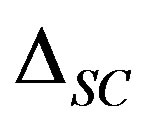

Figure 28. Phase diagram of the d-p model based on the Gutzwiller wave function [106].
were evaluated using the formula  where
where  is the density of states. Here we have set
is the density of states. Here we have set  since
since  is estimated as
is estimated as 
to 3  for optimally doped YBCO using
for optimally doped YBCO using
 [100]. The phase diagram is consistent with the recently reported phase diagram for layered cuprates [145].
[100]. The phase diagram is consistent with the recently reported phase diagram for layered cuprates [145].
3.8. Diagonal Stripe States in the Light-Doping Region
Here we examine whether the relationship  holds in the lower doping region or not, and whether the diagonal stripe state is obtained in the further lower doping region [50]. The elastic neutron scattering experiments of LSCO in the light-doping region,
holds in the lower doping region or not, and whether the diagonal stripe state is obtained in the further lower doping region [50]. The elastic neutron scattering experiments of LSCO in the light-doping region,  , revealed that the position of incommensurate magnetic peaks changed from
, revealed that the position of incommensurate magnetic peaks changed from  to
to  as
as  becomes less than 0.06 [129,130]. This means that the stripe direction rotates by 45 degrees to become diagonal at this transition. In the diagonal stripe states, the magnetic peaks are observed to keep a relation
becomes less than 0.06 [129,130]. This means that the stripe direction rotates by 45 degrees to become diagonal at this transition. In the diagonal stripe states, the magnetic peaks are observed to keep a relation  that holds in the vertical stripe state in the low doping region.
that holds in the vertical stripe state in the low doping region.
In Figure 29, we show the incommensurability of the most stable stripe state as a function of . Open squares and triangles are values for diagonal and vertical incommensurate SDW’s obtained in the elastic neutron scattering experiments on LSCO, respectively. Solid squares and triangles show our results for the diagonal and vertical stripes, respectively. These results are in a good agreement with experimental data. We also found that the phase boundary
. Open squares and triangles are values for diagonal and vertical incommensurate SDW’s obtained in the elastic neutron scattering experiments on LSCO, respectively. Solid squares and triangles show our results for the diagonal and vertical stripes, respectively. These results are in a good agreement with experimental data. We also found that the phase boundary  between the diagonal and vertical stripe states lies at or above 0.0625 in the
between the diagonal and vertical stripe states lies at or above 0.0625 in the
case of  and
and . The following factors may give rise to slight changes of the phase boundary
. The following factors may give rise to slight changes of the phase boundary : the diagonal stripe state may be stabilized in the low-temperature-orthorhombic (LTO) phase in LSCO. The diagonal stripe state is probably stabilized further by forming a line along larger next-nearest hopping direction due to the anisotropic
: the diagonal stripe state may be stabilized in the low-temperature-orthorhombic (LTO) phase in LSCO. The diagonal stripe state is probably stabilized further by forming a line along larger next-nearest hopping direction due to the anisotropic  generated by the Cu-O buckling in the LTO phase.
generated by the Cu-O buckling in the LTO phase.
3.9. Checkerboard States
A checkerboard-like density modulation with a roughly  period (
period ( is a lattice constant) has also been observed by scanning tunneling microscopy (STM) experiments in Bi2Sr2CaCu2O8+d, [146] Bi2Sr2–xLaxCuO6+d, [147] and Ca2–xNaxCuO2Cl2 (Na-CCOC) [148]. It is important to clarify whether these inhomogeneous states can be understood within the framework of strongly correlated electrons.
is a lattice constant) has also been observed by scanning tunneling microscopy (STM) experiments in Bi2Sr2CaCu2O8+d, [146] Bi2Sr2–xLaxCuO6+d, [147] and Ca2–xNaxCuO2Cl2 (Na-CCOC) [148]. It is important to clarify whether these inhomogeneous states can be understood within the framework of strongly correlated electrons.
Possible several electronic checkerboard states have been proposed theoretically [134,149,150]. The charge density  and spin density
and spin density  are spatially modulated as
are spatially modulated as
 (52)
(52)
 (53)
(53)
where  and
and  are variational parameters. The striped incommensurate spin-density wave state (ISDW) is defined by a single Q vector. On the other hand, the checkerboard ISDW state is described by the double-Q set; for example, vertical wave vectors
are variational parameters. The striped incommensurate spin-density wave state (ISDW) is defined by a single Q vector. On the other hand, the checkerboard ISDW state is described by the double-Q set; for example, vertical wave vectors  and
and  describe a spin vertical checkerboard state, where two diagonal domain walls are orthogonal. Diagonal wave vectors
describe a spin vertical checkerboard state, where two diagonal domain walls are orthogonal. Diagonal wave vectors  and
and  lead to a spin diagonal checkerboard state with a
lead to a spin diagonal checkerboard state with a  -period. The hole density forms the charge vertical checkerboard pattern with vertical wave vectors
-period. The hole density forms the charge vertical checkerboard pattern with vertical wave vectors  and
and  in which the hole density is maximal on the crossing point of magnetic domain walls in the spin diagonal checkerboard state. If
in which the hole density is maximal on the crossing point of magnetic domain walls in the spin diagonal checkerboard state. If  is assumed, the charge modulation pattern is consistent with the
is assumed, the charge modulation pattern is consistent with the 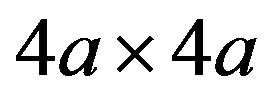 charge structure observed in STM experiments.
charge structure observed in STM experiments.
We found that the coexistent state of bond-centered four-period diagonal and vertical spin-checkerboard structure characterized by a multi-Q set is stabilized and composed of  period checkerboard spin modulation. [151] In Figure 30(a), we show the condensation energies of some heterogeneous states,
period checkerboard spin modulation. [151] In Figure 30(a), we show the condensation energies of some heterogeneous states,  , with fixing the transfer energies
, with fixing the transfer energies  and
and  suitable for Bi-2212. The system is a
suitable for Bi-2212. The system is a  lattice with the electron-filling
lattice with the electron-filling
 . The energy of the normal state
. The energy of the normal state  is calculated by adopting
is calculated by adopting . In our calculations, the condensation energies of both bondcentered stripe and checkerboard states are always larger than those of site-centered stripe and checkerboard states. The vertical stripe state is not suitable in this parameter set since this state is only stabilized with the LSCO-type band. The four-period spin-diagonal checkerboard (DC) state is significantly more stable than the eight-period spin-DC state. We found that the coexistent state of the bond-centered four-period spin-DC and four-period spin-vertical checkerboard (VC) with
. In our calculations, the condensation energies of both bondcentered stripe and checkerboard states are always larger than those of site-centered stripe and checkerboard states. The vertical stripe state is not suitable in this parameter set since this state is only stabilized with the LSCO-type band. The four-period spin-diagonal checkerboard (DC) state is significantly more stable than the eight-period spin-DC state. We found that the coexistent state of the bond-centered four-period spin-DC and four-period spin-vertical checkerboard (VC) with  is most stable, as shown in Figure 30(a). The measured expectation value of the spin density is shown in Figure 30(b).
is most stable, as shown in Figure 30(a). The measured expectation value of the spin density is shown in Figure 30(b).
3.10. Improved Gutzwiller Function
We have presented the results based on the Gutzwiller functions for the normal state, SDW state and BCS state. We must consider a method to go beyond the Gutzwiller function-based Monte Carlo method. One method to achieve this purpose is to multiply the Jastrow correlation operators to take into account the intersite correlations. The simplest possible candidate is an introduction of the diagonal intersite correlation factor [152]:
 (54)
(54)
for the variational parameter . We have investigated the 2D Hubbard model by using the JastrowGutzwiller function [111]. The ground-state energy is lowered considerably by considering the intersite correlations such as nearest neighbor and next nearest neighbor spin and charge correlations.
. We have investigated the 2D Hubbard model by using the JastrowGutzwiller function [111]. The ground-state energy is lowered considerably by considering the intersite correlations such as nearest neighbor and next nearest neighbor spin and charge correlations.
Here we consider the method to improve the wave functions by an off-diagonal Jastrow correlation operators [94,95,153]. The off-diagonal correlation factors are more effective to lower the ground state energy in 2D systems. Let us consider the wave functions  defined in the following way: [95]
defined in the following way: [95]
 (55)
(55)
 (56)
(56)
 (57)
(57)

 (58)
(58)
and so on, where  denotes the kinetic part of the Hamiltonian
denotes the kinetic part of the Hamiltonian
 (59)
(59)
and  denotes the on-site Coulomb interaction.
denotes the on-site Coulomb interaction. ,
,  ,
,  ,
,  ,
,  and
and  are variational parameters. It is considered that
are variational parameters. It is considered that  approaches the true ground state wave function as
approaches the true ground state wave function as  grows larger since the ground state wave function is written as
grows larger since the ground state wave function is written as
 (60)
(60)
for large  and small
and small 
 . If we can extrapolate the expectation values from the data for
. If we can extrapolate the expectation values from the data for , we can evaluate correct expectation values.
, we can evaluate correct expectation values.
The computations are performed by using the discrete Hubbard-Stratonovich transformation as described in Section 3.1. In the evaluation of the expectation values we generate the Monte Carlo samples by the importance sampling [95] with the weight function  where
where
 (61)
(61)
Since the Monte Carlo samplings are generated with the weight , the expectation values are calculated with the sign of
, the expectation values are calculated with the sign of  in the summation over the generated samples. In our calculations the negative sign problem has become less serious due to the variational treatment, although we encounter the inevitable negative sign problem in the standard projector Monte Carlo approaches [154].
in the summation over the generated samples. In our calculations the negative sign problem has become less serious due to the variational treatment, although we encounter the inevitable negative sign problem in the standard projector Monte Carlo approaches [154].
In Figure 31 the energy is shown as a function of  where the SDW and normal states are chosen as the initial state
where the SDW and normal states are chosen as the initial state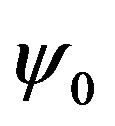 . The extrapolated values for different initial states coincide with each other within Monte Carlo statistical errors. The energy expectation values as a function of
. The extrapolated values for different initial states coincide with each other within Monte Carlo statistical errors. The energy expectation values as a function of  for
for  square lattice are presented in Figure 32 for
square lattice are presented in Figure 32 for ,
,  ,
,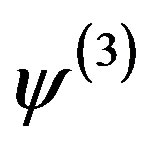 . The extrapolated curve is shown by the solid curve and the results obtained by the quantum Monte Carlo simulation (QMC) [28] are also shown as a reference. A good agreement between two calculations support the method although the QMC gives slightly higher energy for
. The extrapolated curve is shown by the solid curve and the results obtained by the quantum Monte Carlo simulation (QMC) [28] are also shown as a reference. A good agreement between two calculations support the method although the QMC gives slightly higher energy for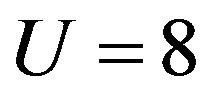 .
.
One can formulate an approach to consider the BCS function with correlation operators. [96] For this end the electron-hole transformation is introduced for the down spin and the up-spin electrons are unaltered [155]. We show the energy versus  in Figure 33 for
in Figure 33 for  and
and . From an extrapolation to the limit
. From an extrapolation to the limit , both formulations predict the same limiting value for the energy. The energy is lowered considerably due to the
, both formulations predict the same limiting value for the energy. The energy is lowered considerably due to the
correlation operators compared to that for the Gutzwiller function. The energy in the d-wave SC state is always lower than that in the normal state for each . The energy gain in the SC state remains the same order after the multiplication of correlation factors.
. The energy gain in the SC state remains the same order after the multiplication of correlation factors.
3.11. 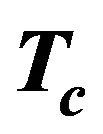 and
and 
Relationships between  and structural features in cuprate high-temperature superconductors are very interesting. Torrance and Metzger found the first such relationship between
and structural features in cuprate high-temperature superconductors are very interesting. Torrance and Metzger found the first such relationship between  and the Madelung potential difference
and the Madelung potential difference  [156]. Here
[156]. Here  is the potential difference between Cu and O sites in the CuO
is the potential difference between Cu and O sites in the CuO plane.
plane.  was found to increase with decreasing
was found to increase with decreasing . There is an interesting tendency of increasing
. There is an interesting tendency of increasing  with increasing relative ratio of hole density at oxygen site against that at copper site [117].
with increasing relative ratio of hole density at oxygen site against that at copper site [117].
Here we show the results obtained by using the perturbation theory [62-66], There have been many similar works by making some kind of approximation such as random phase approximation (RPA) [157-159], fluctuation-exchange approximation (FLEX) [160-163], effective spin-fluctuation method [4,164,165], and perturbation theory in terms of U [166-168]. An application was made for Sr2RuO4 where we need to consider th emulti-band structure α and β orbitals [169], and also to the three-dimensional d-p model [170]. In our formulation the gap function is written as
 (62)
(62)
The exponent  indicates the strength of superconductivity. The results are in Figures 34 and 35 [171]. As shown in the figure, for positive
indicates the strength of superconductivity. The results are in Figures 34 and 35 [171]. As shown in the figure, for positive , with increase of
, with increase of  the exponent
the exponent  increases monotonously. This means the increase of superconducting gap and so of
increases monotonously. This means the increase of superconducting gap and so of , and is consistent with the wide-range tendency of the variational Monte Carlo calculation [24,172]. This tendency can be understood in terms of
, and is consistent with the wide-range tendency of the variational Monte Carlo calculation [24,172]. This tendency can be understood in terms of
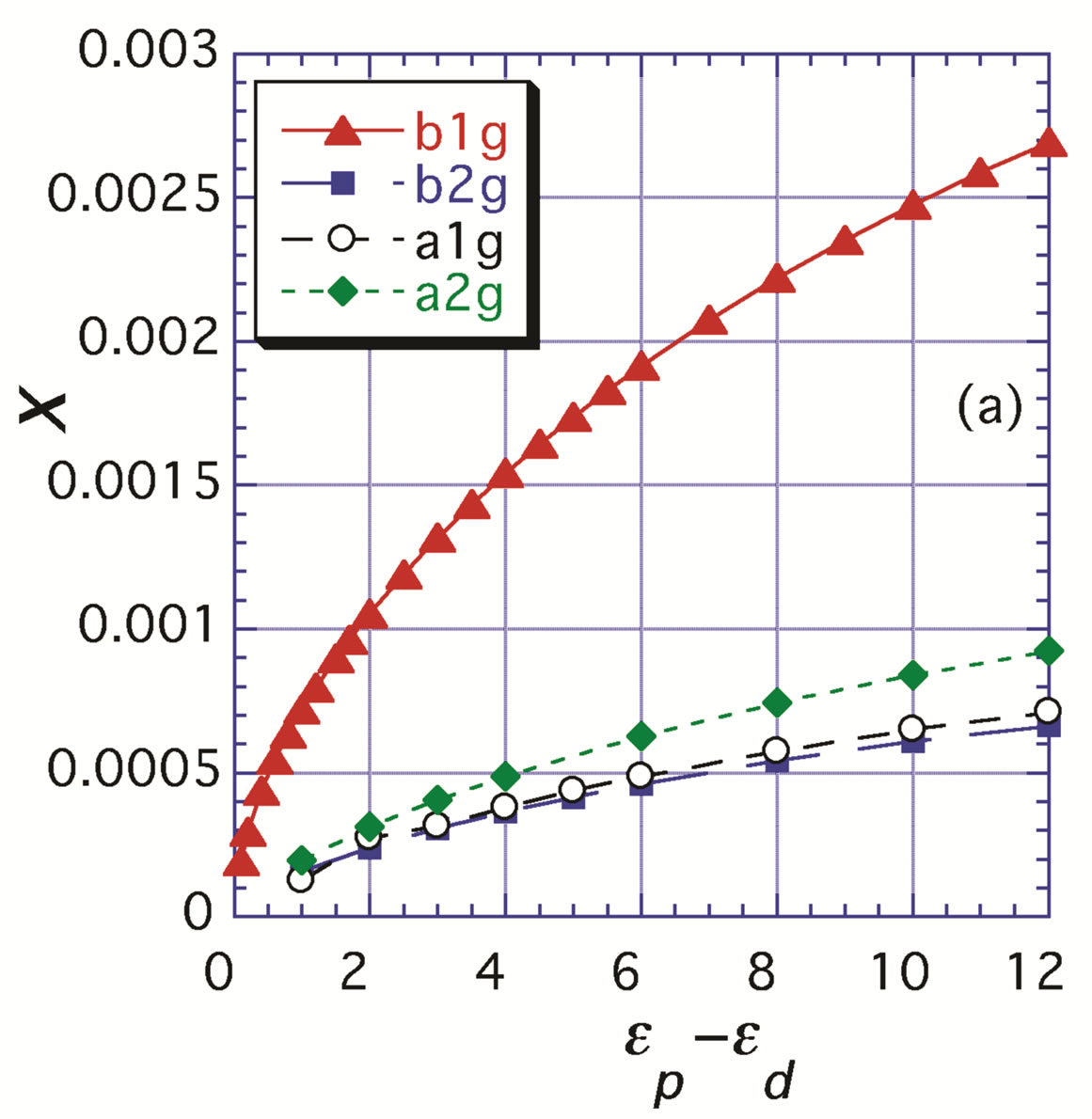
Figure 34. The exponent x (superconductivity strength) as a function of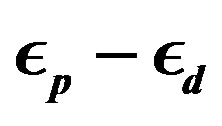 , where the level difference
, where the level difference  is positive.
is positive.

Figure 35. The exponent x as a function of , where the level difference
, where the level difference  is negative.
is negative.
 (63)
(63)
where  is the weight ofd electrons. This clearly indicates that increase of
is the weight ofd electrons. This clearly indicates that increase of  leads to the increase of
leads to the increase of  and subsequently of
and subsequently of . In the case of
. In the case of , we take account of finite Coulomb repulsion
, we take account of finite Coulomb repulsion  on oxygen sites. The effective interaction coming from
on oxygen sites. The effective interaction coming from  is similarly given by the susceptibility with the weight of
is similarly given by the susceptibility with the weight of  electrons. The results of
electrons. The results of  with
with  indicates that all four types of even parity (
indicates that all four types of even parity ( ,
,  ,
,  and
and ) SC strength values increase, so that
) SC strength values increase, so that  is raised, as the absolute value
is raised, as the absolute value  increases in this region. This result shows that
increases in this region. This result shows that 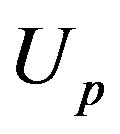 also plays an important role as well.
also plays an important role as well.
Let us give a discussion on this result. Increase of 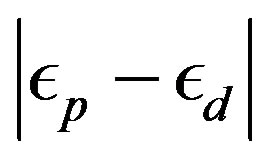 in the region of
in the region of 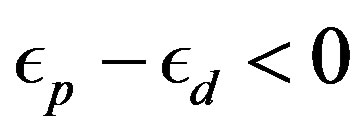 means decrease of
means decrease of  since
since
 , where
, where  is the second electron affinity of oxygen atom and
is the second electron affinity of oxygen atom and 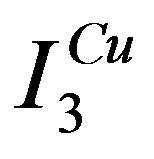 is the third electron ionicity of copper atom and
is the third electron ionicity of copper atom and  is the charge of electron. Therefore, this relation is consistent with the systematics reported in [156]. With increase of the distance of the apex oxygen away from the CuO2 plane, cuprate superconductors are known to increase
is the charge of electron. Therefore, this relation is consistent with the systematics reported in [156]. With increase of the distance of the apex oxygen away from the CuO2 plane, cuprate superconductors are known to increase  [173]. The accompanying raise of
[173]. The accompanying raise of  should tend to increase
should tend to increase .
.
The Coulomb interaction between p electrons on oxygen atom will raise the level of p electrons effectively. This leads to the lowering of p hole level  or the raise of
or the raise of  relatively. This indicates that
relatively. This indicates that  will be increased by the Coulomb interaction between p electrons.
will be increased by the Coulomb interaction between p electrons.
4. Quantum Monte Carlo Studies
4.1. Quantum Monte Carlo Method
The Quantum Monte Carlo (QMC) method is a numerical method that is employed to simulate the behavior of correlated electron systems. We outline the QMC method in this section. The Hamiltonian is the Hubbard model that contains the on-site Coulomb repulsion and is written as
 (64)
(64)
where 
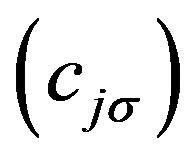 is the creation (annihilation) operator of an electron with spin
is the creation (annihilation) operator of an electron with spin  at the
at the  -th site and
-th site and .
.  is the transfer energy between the sites
is the transfer energy between the sites  and
and .
.  for the nearest-neighbor bonds. For all other cases
for the nearest-neighbor bonds. For all other cases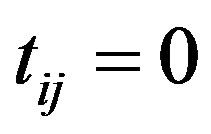 .
.  is the on-site Coulomb energy. The number of sites is
is the on-site Coulomb energy. The number of sites is  and the linear dimension of the system is denoted as
and the linear dimension of the system is denoted as . The energy unit is given by
. The energy unit is given by  and the number of electrons is denoted as
and the number of electrons is denoted as .
.
In a Quantum Monte Carlo simulation, the ground state wave function is
 (65)
(65)
where  is the initial one-particle state represented by a Slater determinant. For large
is the initial one-particle state represented by a Slater determinant. For large ,
,  will project out the ground state from
will project out the ground state from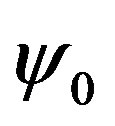 . We write the Hamiltonian as
. We write the Hamiltonian as  where K and V are the kinetic and interaction terms of the Hamiltonian in Equation (64), respectively. The wave function in Equation (65) is written as
where K and V are the kinetic and interaction terms of the Hamiltonian in Equation (64), respectively. The wave function in Equation (65) is written as
 (66)
(66)
for . Using the Hubbard-Stratonovich transformation [27,94], we have
. Using the Hubbard-Stratonovich transformation [27,94], we have
 (67)
(67)
for  or
or . The wave function is expressed as a summation of the one-particle Slater determinants over all the configurations of the auxiliary fields
. The wave function is expressed as a summation of the one-particle Slater determinants over all the configurations of the auxiliary fields . The exponential operator is expressed as
. The exponential operator is expressed as
 (68)
(68)
where we have defined
 (69)
(69)
for
 (70)
(70)
 (71)
(71)
The ground-state wave function is
 (72)
(72)
where  is a Slater determinant corresponding to a configuration
is a Slater determinant corresponding to a configuration 
 of the auxiliary fields:
of the auxiliary fields:
 (73)
(73)
The coefficients  are constant real numbers:
are constant real numbers: . The initial state
. The initial state  is a one-particle state. If electrons occupy the wave numbers
is a one-particle state. If electrons occupy the wave numbers  for each spin
for each spin ,
,  is given by the product
is given by the product  where
where  is the matrix represented as [31]
is the matrix represented as [31]
 (74)
(74)
 is the number of electrons for spin
is the number of electrons for spin . In actual calculations we can use a real representation where the matrix elements are
. In actual calculations we can use a real representation where the matrix elements are  or
or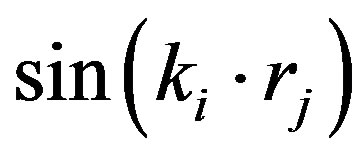 . In the real-space representation, the matrix of
. In the real-space representation, the matrix of  is a diagonal matrix given as
is a diagonal matrix given as
 (75)
(75)
The matrix elements of  are
are
 (76)
(76)
 is an
is an 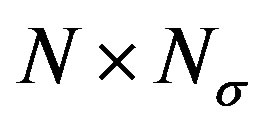 matrix given by the product of the matrices
matrix given by the product of the matrices ,
,  and
and . The inner product is thereby calculated as a determinant [38],
. The inner product is thereby calculated as a determinant [38],
 (77)
(77)
The expectation value of the quantity  is evaluated as
is evaluated as
 (78)
(78)
If  is a bilinear operator
is a bilinear operator 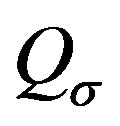 for spin
for spin , we have
, we have
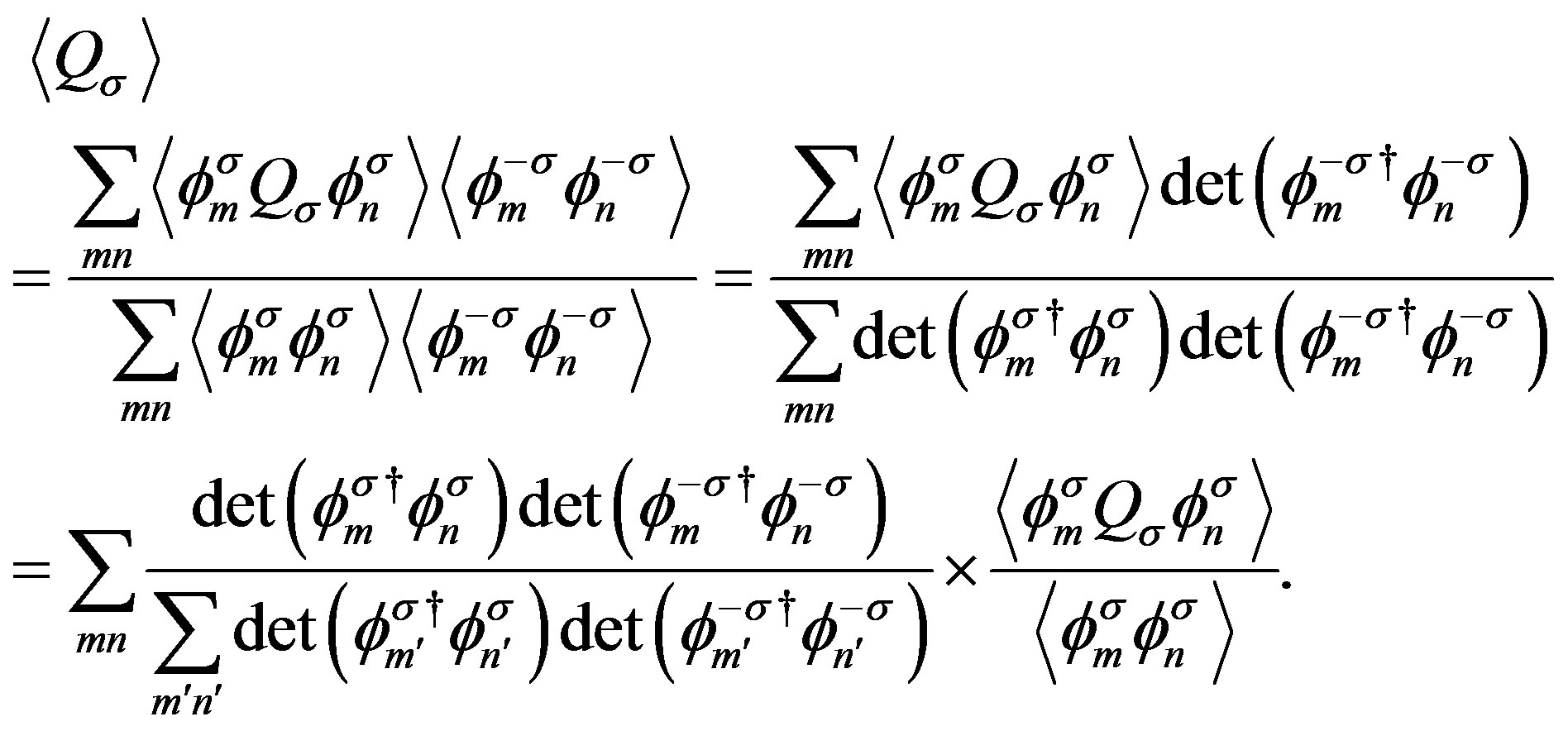 (79)
(79)
The expectation value with respect to the Slater determinants  is evaluated using the singleparticle Green’s function [31,38],
is evaluated using the singleparticle Green’s function [31,38],
 (80)
(80)
In the above expression,
 (81)
(81)
can be regarded as the weighting factor to obtain the Monte Carlo samples. Since this quantity is not necessarily positive definite, the weighting factor should be ; the resulting relationship is,
; the resulting relationship is,
 (82)
(82)
where  and
and
 (83)
(83)
This relation can be evaluated using a Monte Carlo procedure if an appropriate algorithm, such as the Metropolis or heat bath method, is employed [94]. The summation can be evaluated using appropriately defined Monte Carlo samples,
 (84)
(84)
where  is the number of samples. The sign problem is an issue if the summation of
is the number of samples. The sign problem is an issue if the summation of  vanishes within statistical errors. In this case it is indeed impossible to obtain definite expectation values.
vanishes within statistical errors. In this case it is indeed impossible to obtain definite expectation values.
4.2. Quantum Monte Carlo Diagonalization
4.2.1. Basic Method and Optimization
Quantum Monte Carlo diagonalization (QMD) is a method for the evaluation of 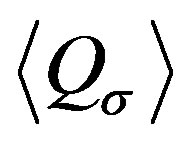 without the negative sign problem [41]. A bosonic version of this method was developed before in Ref.[174]. The configuration space of the probability
without the negative sign problem [41]. A bosonic version of this method was developed before in Ref.[174]. The configuration space of the probability 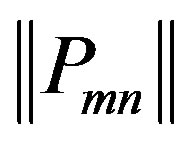 in Equation (84) is generally very strongly peaked. The sign problem lies in the distribution of
in Equation (84) is generally very strongly peaked. The sign problem lies in the distribution of  in the configuration space. It is important to note that the distribution of the basis functions
in the configuration space. It is important to note that the distribution of the basis functions 
 is uniform since
is uniform since  are constant numbers:
are constant numbers: . In the subspace
. In the subspace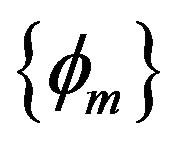 , selected from all configurations of auxiliary fields, the right-hand side of Equation (78) can be determined. However, the large number of basis states required to obtain accurate expectation values is beyond the current storage capacity of computers. Thus we use the variational principle to obtain the expectation values.
, selected from all configurations of auxiliary fields, the right-hand side of Equation (78) can be determined. However, the large number of basis states required to obtain accurate expectation values is beyond the current storage capacity of computers. Thus we use the variational principle to obtain the expectation values.
From the variational principle,
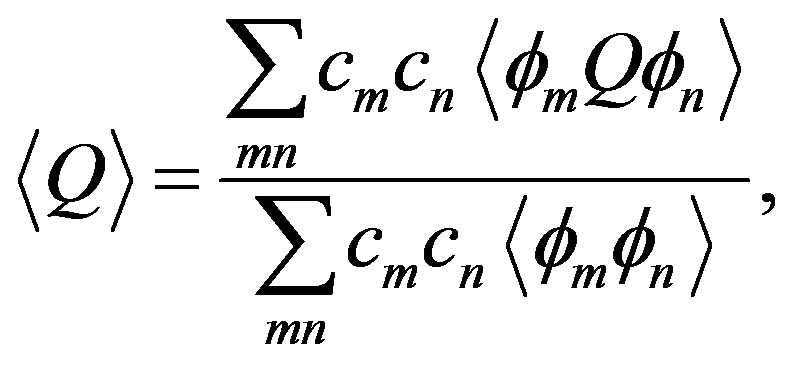 (85)
(85)
where 
 are variational parameters. In order to minimize the energy
are variational parameters. In order to minimize the energy
 (86)
(86)
the equation 
 is solved for,
is solved for,
 (87)
(87)
If we set
 (88)
(88)
 (89)
(89)
the eigen-equation is
 (90)
(90)
for . Since
. Since 
 are not necessarily orthogonal,
are not necessarily orthogonal,  is not a diagonal matrix. We diagonalize the Hamiltonian
is not a diagonal matrix. We diagonalize the Hamiltonian , and then calculate the expectation values of correlation functions with the ground state eigenvector.
, and then calculate the expectation values of correlation functions with the ground state eigenvector.
In Quantum Monte Carlo simulations an extrapolation is performed to obtain the expectation values for the ground-state wave function. If  is large enough, the wave function in Equation (72) will approach the exact ground-state wave function,
is large enough, the wave function in Equation (72) will approach the exact ground-state wave function,  , as the number of basis functions,
, as the number of basis functions,  , is increased. If the number of basis functions is large enough, the wave function will approach,
, is increased. If the number of basis functions is large enough, the wave function will approach,  , as
, as  is increased. In either case the method employed for the reliable extrapolation of the wave function is a key issue in calculating the expectation values. The variance method was recently proposed in variational and Quantum Monte Carlo simulations, where the extrapolation is performed as a function of the energy variance. We can expect linearity in some cases [175]:
is increased. In either case the method employed for the reliable extrapolation of the wave function is a key issue in calculating the expectation values. The variance method was recently proposed in variational and Quantum Monte Carlo simulations, where the extrapolation is performed as a function of the energy variance. We can expect linearity in some cases [175]:
 (91)
(91)
where  denotes the variance defined as
denotes the variance defined as
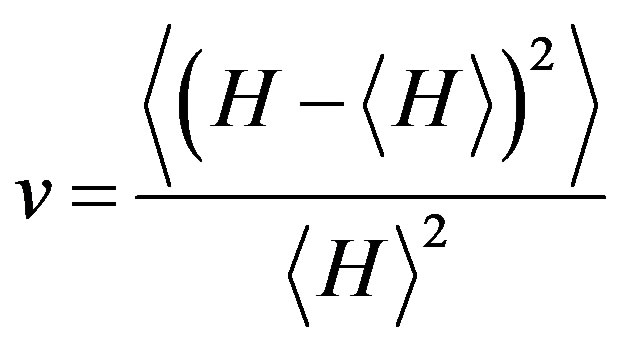 (92)
(92)
and 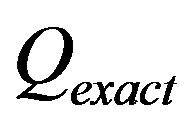 is the expected exact value of the quantity
is the expected exact value of the quantity .
.
The simplest procedure for optimizing the groundstate wave function is to increase the number of basis states  by random sampling. First, we set
by random sampling. First, we set  and
and , for example,
, for example,  , and
, and . We denote the number of basis functions as
. We denote the number of basis functions as . We start with
. We start with  and then increase up to 10,000. This procedure can be outlined as follows:
and then increase up to 10,000. This procedure can be outlined as follows:
1) Generate the auxiliary fields 
 in
in  randomly for
randomly for  for
for 
 , and generate
, and generate  basis wave function
basis wave function .
.
2) Evaluate the matrices  and
and , and diagonalize the matrix
, and diagonalize the matrix  to obtain
to obtain . Then calculate the expectation values and the energy variance.
. Then calculate the expectation values and the energy variance.
3) Repeat the procedure from 1) after increasing the number of basis functions.
For small systems this random method produces reliable energy results. The diagonalization plays an importance producing fast convergence. In order to lower the ground-state energy efficiently, we can employ a genetic algorithm [176] to generate the basis set from the initial basis set. One idea is to replace some parts of 
 in
in  that has the large weight
that has the large weight  to generate a new basis function
to generate a new basis function . The new basis function
. The new basis function  obtained in this way is expected to also have a large weight and contribute to
obtained in this way is expected to also have a large weight and contribute to . The details of the method are shown in Ref.[41].
. The details of the method are shown in Ref.[41].
4.2.2. Ground State Energy and Correlation Functions
The energy as a function of the variance is presented in Figures 36-38 for ,
,  and
and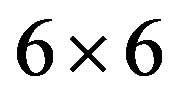 , respectively. To obtain these results the genetic algorithm was employed to produce the basis functions except the open symbols in Figure 4. The
, respectively. To obtain these results the genetic algorithm was employed to produce the basis functions except the open symbols in Figure 4. The  where
where  in Figure 2 is the energy for the closed shell case up to 2000 basis states. The other two figures are for open shell cases, where evaluations were performed up to 3000 states. We show the results for the
in Figure 2 is the energy for the closed shell case up to 2000 basis states. The other two figures are for open shell cases, where evaluations were performed up to 3000 states. We show the results for the ,
, 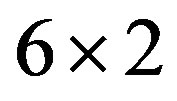 and
and  systems in Table 2.
systems in Table 2.
The Figure 39 is the momentum distribution function ,
,
 (93)
(93)
for  sites where the results for the Gutzwiller VMC and the QMD are indicated. The Gutzwiller function gives the results that
sites where the results for the Gutzwiller VMC and the QMD are indicated. The Gutzwiller function gives the results that 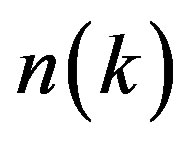 increases as
increases as  approaches
approaches 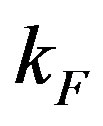 from above the Fermi surface. This is clearly unphysical. This flaw of the Gutzwiller function near the Fermi surface is not observed for the QMD result.
from above the Fermi surface. This is clearly unphysical. This flaw of the Gutzwiller function near the Fermi surface is not observed for the QMD result.
4.2.3. Spin Gap in the Hubbard Ladder
Here we show the results for one-dimensional models. The ground state of the 1D Hubbard model is no longer Fermi liquid for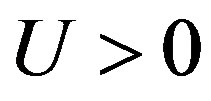 . The ground state is insulating at half-filling and metallic for less than half-filling. The Figure 40 is the spin and charge correlation functions,
. The ground state is insulating at half-filling and metallic for less than half-filling. The Figure 40 is the spin and charge correlation functions,  and
and , as a function of the wave number, for
, as a function of the wave number, for

Table 2. Ground state energy per site from the Hubbard model. The boundary conditions are periodic in both directions. The current results are presented under the column labeled QMD. The constrained path Monte Carlo (CPMC) results are from Ref.[38]. The column VMC is the results obtained for the optimized variational wave function  except for 6 × 2 for which
except for 6 × 2 for which  is employed. The QMC results are from Ref.[35]. Exact results are obtained using diagonalization [177].
is employed. The QMC results are from Ref.[35]. Exact results are obtained using diagonalization [177].

Figure 37. Energy as a function of the variance for 6 × 2  and
and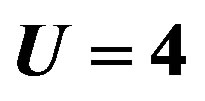 . The square is the exact value obtained using exact diagonalization.
. The square is the exact value obtained using exact diagonalization.

Figure 38. Energy as a function of the variance  for 6 × 6. with the periodic boundary conditions. Solid circles and crosses are data obtained from the QMD method for two different initial configurations of the auxiliary fields. Gray open circles show results obtained from the
for 6 × 6. with the periodic boundary conditions. Solid circles and crosses are data obtained from the QMD method for two different initial configurations of the auxiliary fields. Gray open circles show results obtained from the  -renormalization method with 300 basis wave functions.
-renormalization method with 300 basis wave functions.

Figure 39. Momentum distribution function for the 14 × 14 lattice. Parameters are 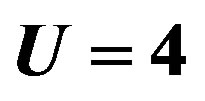 and
and . The boundary conditions are periodic in both directions. The results for the Gutzwiller function (open circle) are also provided.
. The boundary conditions are periodic in both directions. The results for the Gutzwiller function (open circle) are also provided.
the 1D Hubbard model where . The
. The  singularity can be clearly identified where the dotted line is for
singularity can be clearly identified where the dotted line is for . The spin correlation is enhanced and the charge correlation function is suppressed slightly because of the Coulomb interaction.
. The spin correlation is enhanced and the charge correlation function is suppressed slightly because of the Coulomb interaction.
The spin correlation function 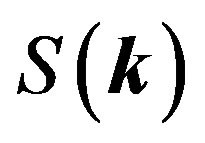 for the Hubbard ladder is presented in Figure 41, where
for the Hubbard ladder is presented in Figure 41, where  and
and .
.  is defined as
is defined as
 (94)
(94)
where  denotes the site
denotes the site 
 . We use the convention that
. We use the convention that  where
where  and
and  indicate the lower band and upper band, respectively. There are four singularities at
indicate the lower band and upper band, respectively. There are four singularities at ,
,  ,
,  , and
, and  for the Hubbard ladder, where
for the Hubbard ladder, where  and
and  are the Fermi wave numbers of the lower and upper band, respectively.
are the Fermi wave numbers of the lower and upper band, respectively.

Figure 40. Spin (solid circle) and charge (open circle) correlation functions obtained from the QMD method for the one-dimensional Hubbard model with 80 sites. The number of electrons is 66. We set  and use the periodic boundary condition.
and use the periodic boundary condition.
It has been expected that the charge gap opens up as  turns on at half-filling for the Hubbard ladder model. In Figure 42 the charge gap at half-filling is shown as a function of
turns on at half-filling for the Hubbard ladder model. In Figure 42 the charge gap at half-filling is shown as a function of . The charge gap is defined as
. The charge gap is defined as
 (95)
(95)
where  is the ground state energy for the
is the ground state energy for the  electrons. The charge gap in Figure 42 was estimated using the extrapolation to the infinite system from the data for the
electrons. The charge gap in Figure 42 was estimated using the extrapolation to the infinite system from the data for the ,
,  , and
, and  systems. The data suggest the exponentially small charge gap for small
systems. The data suggest the exponentially small charge gap for small  or the existence of the critical value
or the existence of the critical value  in the range of
in the range of , below which the charge gap vanishes.
, below which the charge gap vanishes.
4.2.4. Magnetization in 2D Hubbard Model
The ground state of the 2D Hubbard model at half-filling is antiferromagnetic for  because of the nesting due to the commensurate vector
because of the nesting due to the commensurate vector . The Gutzwiller function predicts that the magnetization
. The Gutzwiller function predicts that the magnetization
 (96)
(96)
increases rapidly as  increases and approaches
increases and approaches  for large
for large . In Figure 43, the QMD results are presented for
. In Figure 43, the QMD results are presented for  as a function of
as a function of . The previous results obtained using the QMC method are plotted as open circles. The gray circles are for the
. The previous results obtained using the QMC method are plotted as open circles. The gray circles are for the  -function VMC method and squares are the Gutzwiller VMC data. Clearly, the magnetization is reduced considerably because of the fluctuations, and is smaller than the Gutzwiller VMC method by about 50 percent.
-function VMC method and squares are the Gutzwiller VMC data. Clearly, the magnetization is reduced considerably because of the fluctuations, and is smaller than the Gutzwiller VMC method by about 50 percent.
4.3. Pair Correlation Function
The pair correlation function 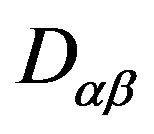 is defined by
is defined by

Figure 42. Charge gap as a function of  for
for  (circles). The DMRG results (squares) are provided for comparison [58].
(circles). The DMRG results (squares) are provided for comparison [58].
 (97)
(97)
where  ,
, 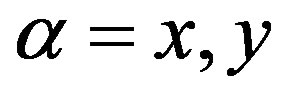 , denote the annihilation operators of the singlet electron pairs for the nearestneighbor sites:
, denote the annihilation operators of the singlet electron pairs for the nearestneighbor sites:
 (98)
(98)
Here  is a unit vector in the
is a unit vector in the  -direction. We consider the correlation function of d-wave pairing:
-direction. We consider the correlation function of d-wave pairing:
 (99)
(99)
where
 (100)
(100)
 and
and 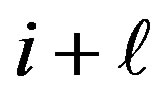 denote sites on the lattice.
denote sites on the lattice.
We show how the pair correlation function is evaluated in quantum Monte Carlo methods. We show the pair correlation functions 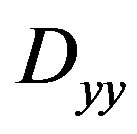 and
and 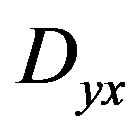 on the lattice
on the lattice  in Figures 44 and 45. The boundary condition is open in the 4-site direction and is periodic in the other direction. An extrapolation is performed as a function of
in Figures 44 and 45. The boundary condition is open in the 4-site direction and is periodic in the other direction. An extrapolation is performed as a function of  in the QMC method with Metropolis algorithm and as a function of the energy variance
in the QMC method with Metropolis algorithm and as a function of the energy variance  in the QMD method with diagonalization. We keep
in the QMD method with diagonalization. We keep  a small constant
a small constant  and and increase
and and increase , where
, where  is the division number. In the Metropolis QMC method, we calculated averages over
is the division number. In the Metropolis QMC method, we calculated averages over  Monte Carlo steps. The exact values were obtained by using the exact diagonalization method. Two methods give consistent results as shown in figures. All
Monte Carlo steps. The exact values were obtained by using the exact diagonalization method. Two methods give consistent results as shown in figures. All
the  and
and 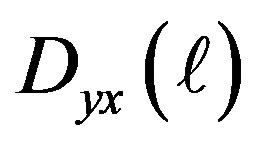 are suppressed on
are suppressed on  as
as  is increased. In general, the pair correlation functions are suppressed in small systems. In Figures 46 and 47, we show the inter-chain pair correlation function for the ladder model
is increased. In general, the pair correlation functions are suppressed in small systems. In Figures 46 and 47, we show the inter-chain pair correlation function for the ladder model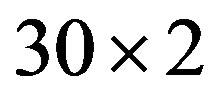 . We use the open boundary condition. The number of electrons is
. We use the open boundary condition. The number of electrons is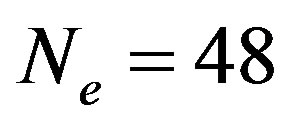 , and the strength of the Coulomb interaction is
, and the strength of the Coulomb interaction is .
.  indicates the electron pair along the rung, and
indicates the electron pair along the rung, and 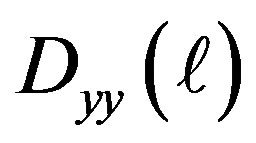 is the expectation value of the parallel movement of the pair along the ladder. The results obtained by two methods are in good agreement except
is the expectation value of the parallel movement of the pair along the ladder. The results obtained by two methods are in good agreement except 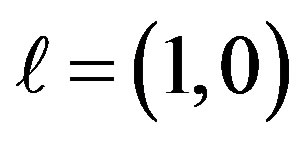 (nearest-neighbor correlation).
(nearest-neighbor correlation).
We first consider the half-filled case with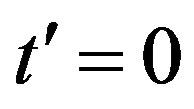 ; in this case the antiferromagnetic correlation is dominant over the superconductive pairing correlation and thus the pairing correlation function is suppressed as the Coulomb repulsion
; in this case the antiferromagnetic correlation is dominant over the superconductive pairing correlation and thus the pairing correlation function is suppressed as the Coulomb repulsion  is increased. The Figure 48 exhibits the d-wave pairing correlation function
is increased. The Figure 48 exhibits the d-wave pairing correlation function  on
on  lattice as a function of the distance. The
lattice as a function of the distance. The  is suppressed due to the on-site Coulomb interaction, as expected. Its reduction is, however, not so considerably large compared to previous QMC studies [39] where the pairing correlation is almost annihilated for
is suppressed due to the on-site Coulomb interaction, as expected. Its reduction is, however, not so considerably large compared to previous QMC studies [39] where the pairing correlation is almost annihilated for . We then turn to the case of less than half-filling. We show the results on
. We then turn to the case of less than half-filling. We show the results on  with electron number
with electron number . We show
. We show  as a function of the distance in Figure 49
as a function of the distance in Figure 49 . In the scale of this figure,
. In the scale of this figure,  for
for  is almost the same as that of the non-interacting case, and is enhanced slightly for large
is almost the same as that of the non-interacting case, and is enhanced slightly for large . Our results indicate that the pairing correlation is not suppressed and is indeed enhanced by the Coulomb interaction
. Our results indicate that the pairing correlation is not suppressed and is indeed enhanced by the Coulomb interaction , and its enhancement is very small.
, and its enhancement is very small.
The Figure 50 shows  on
on  lattice. This also indicates that the pairing correlation function is
lattice. This also indicates that the pairing correlation function is
enhanced for . There is a tendency that
. There is a tendency that  is easily suppressed as the system size becomes small. We estimated the enhancement ratio compared to the non-interacting case
is easily suppressed as the system size becomes small. We estimated the enhancement ratio compared to the non-interacting case  at
at 
for  as shown in Figure 51. This ratio increases as the system size is increased. To compute the enhancement, we picked the sites, for example on
as shown in Figure 51. This ratio increases as the system size is increased. To compute the enhancement, we picked the sites, for example on 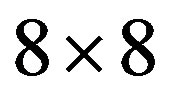 lattice,
lattice,  , (4,0), (4,1), (3,3), (4,2), (4,3), (5,0), (5,1) with
, (4,0), (4,1), (3,3), (4,2), (4,3), (5,0), (5,1) with  and evaluate the mean value. In our computations, the ratio increases almost linearly indicating a possibility of superconductivity. This indicates
and evaluate the mean value. In our computations, the ratio increases almost linearly indicating a possibility of superconductivity. This indicates  for
for .
.
Because , we obtain
, we obtain
 for
for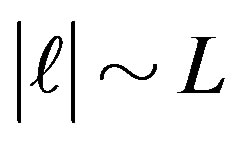 . This indicates that the exponent of the power law is 2. When
. This indicates that the exponent of the power law is 2. When , the
, the
enhancement is small and is almost independent of . In the low density case, the enhancement is also suppressed being equal to 1. In Figure 52, the enhancement ratio is shown as a function of the electron density
. In the low density case, the enhancement is also suppressed being equal to 1. In Figure 52, the enhancement ratio is shown as a function of the electron density  for
for . A dome structure emerges even in small systems. The square in Figure 52 indicates the result for the half-filled case with
. A dome structure emerges even in small systems. The square in Figure 52 indicates the result for the half-filled case with  on
on  lattice. This is the open shell case and causes a difficulty in computations as a result of the degeneracy due to partially occupied electrons. The inclusion of
lattice. This is the open shell case and causes a difficulty in computations as a result of the degeneracy due to partially occupied electrons. The inclusion of  enhances
enhances  compared to the case with
compared to the case with  on
on  lattice.
lattice.  is, however, not enhanced over the non-interacting case at half-filling. This also holds for
is, however, not enhanced over the non-interacting case at half-filling. This also holds for
 lattice where the enhancement ratio
lattice where the enhancement ratio . This indicates the absence of superconductivity at half-filling.
. This indicates the absence of superconductivity at half-filling.
4.4. Spin Susceptibility
We propose a method to compute the magnetic susceptibility at absolute zero 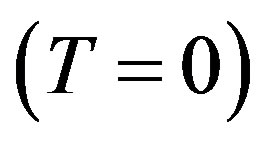 [178]. We add the source term
[178]. We add the source term  to the Hamiltonian as follows
to the Hamiltonian as follows
 (101)
(101)
where  is a small real number of the order
is a small real number of the order  or
or . We calculate
. We calculate  in the ground state, which is, as shown by the linear response theory, the magnetic susceptibility
in the ground state, which is, as shown by the linear response theory, the magnetic susceptibility
 (102)
(102)
in the limit of small , where
, where  is the retarded Green function and
is the retarded Green function and 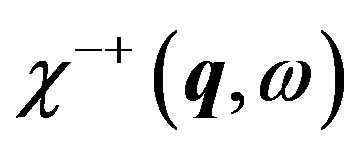 is the dynamical susceptibility,
is the dynamical susceptibility,
 (103)
(103)
Indeed, the above formula gives the correct spin susceptibility  on the finite lattice for the noninteracting case, which is given by
on the finite lattice for the noninteracting case, which is given by  with the Fermi distribution function
with the Fermi distribution function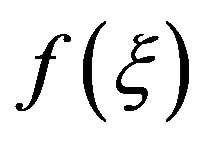 . We calculate
. We calculate  by using the quantum Monte Carlo method to obtain
by using the quantum Monte Carlo method to obtain .
.
We examine the results obtained for the susceptibilities. Figure 53 shows the spin susceptibility  for
for 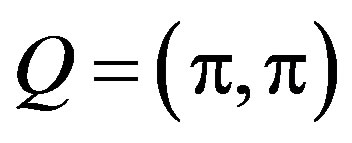 on a
on a  lattice as a function of
lattice as a function of  or the energy variance
or the energy variance . The number of electrons is 10. The expectation values agree well with exact values given by the exact diagonalization method.
. The number of electrons is 10. The expectation values agree well with exact values given by the exact diagonalization method.
We now compute the staggered susceptibility  by adding the source term
by adding the source term
 to the Hamiltonianwhere
to the Hamiltonianwhere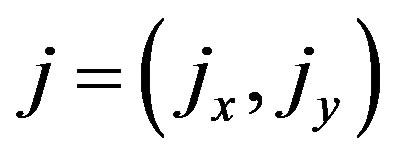 . Here we set the periodic and antiperiodic boundary conditions in the
. Here we set the periodic and antiperiodic boundary conditions in the  and
and  directions, respectively, to avoid a numerical difficulty caused by the degeneracy between states
directions, respectively, to avoid a numerical difficulty caused by the degeneracy between states  and
and 
where . It has been shown that a long-range spin correlation exists in the ground state of the half-filled Hubbard model with
. It has been shown that a long-range spin correlation exists in the ground state of the half-filled Hubbard model with  for
for  [40, 41,179,180]. In the case
[40, 41,179,180]. In the case ,
,  exhibits a double logarithmic behavior
exhibits a double logarithmic behavior .
.  is shown as a function of
is shown as a function of  in Figure 54 for
in Figure 54 for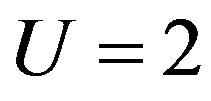 , 3, and 4. The obtained values are well fitted by
, 3, and 4. The obtained values are well fitted by  and
and  diverges in the limit of a large system size
diverges in the limit of a large system size :
:
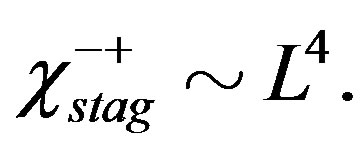 (104)
(104)
This result is consistent with the existence of the long-range spin correlation for  [179,180]. The degree of divergence of
[179,180]. The degree of divergence of  is beyond the criterion of the Kosterlitz-Thouless transition, and thus the long-range order represented by
is beyond the criterion of the Kosterlitz-Thouless transition, and thus the long-range order represented by  belongs to a different category. The
belongs to a different category. The  behavior of
behavior of  is consistent with the predictions of perturbation theory in the 2D non-linear sigma model at low temperatures [181].
is consistent with the predictions of perturbation theory in the 2D non-linear sigma model at low temperatures [181].
4.5. Pair Susceptibility
In this section we consider a method to evaluate the pair susceptibility  at
at . In order to compute the pair susceptibility, we use an electron-hole transformation for the down spin,
. In order to compute the pair susceptibility, we use an electron-hole transformation for the down spin, 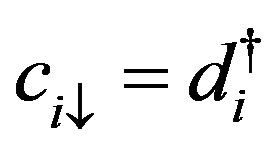 , whereas the up-spin electrons are unaltered,
, whereas the up-spin electrons are unaltered, . For the on-site s-wave pairing, the source term is given by the following expression
. For the on-site s-wave pairing, the source term is given by the following expression
 (105)
(105)
For the anisotropic d-wave pairing, we add
 (106)
(106)
where  and
and . The s-wave and d-wave pair susceptibility are respectively:
. The s-wave and d-wave pair susceptibility are respectively:

 (107)
(107)
Using the Fourier transformation, the source term for the pair potential is written as follows  for
for  or
or  with the
with the  -dependence factor
-dependence factor . If we define
. If we define , then for a small value of
, then for a small value of , we have the following
, we have the following
 (108)
(108)
where
 (109)
(109)
for  and
and . On the basis of analytic continuation, using the thermal Green function,
. On the basis of analytic continuation, using the thermal Green function,  is written as
is written as
 (110)
(110)
In the noninteracting system, this formula exhibits logarithmic divergence on the finite lattice :
:  with constants
with constants  and
and , which can be confirmed by numerical estimations on finite systems.
, which can be confirmed by numerical estimations on finite systems.
In the Kosterlitz-Thouless theory, the susceptibility is scaled as follows [182,183]: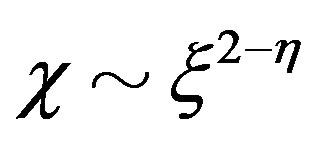 , where
, where  is the coherence length.
is the coherence length.  is of order
is of order  on a lattice
on a lattice  if long-range coherence exists. The exponent
if long-range coherence exists. The exponent  is expected to be 0 at absolute zero. Thus
is expected to be 0 at absolute zero. Thus  scales as
scales as  in the ground state if the Kosterlitz-Thouless transition occurs at some temperature.
in the ground state if the Kosterlitz-Thouless transition occurs at some temperature.
First, we investigate  for the attractive Coulomb interaction
for the attractive Coulomb interaction . For this model, the existence of a Kosterlitz-Thouless transition has been predicted on the basis of quantum Monte Carlo methods [34,183]. The results in Figure 55 show that the size dependence for
. For this model, the existence of a Kosterlitz-Thouless transition has been predicted on the basis of quantum Monte Carlo methods [34,183]. The results in Figure 55 show that the size dependence for  and
and 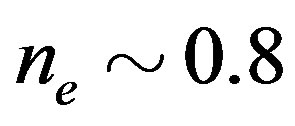 is
is
 (111)
(111)
which is consistent with previous studies, and shows the existence of a Kosterlitz-Thouless transition for the attractive interaction. At near half-filling,  is more enhanced than that at
is more enhanced than that at . Second, let us investigate the d-wave pair susceptibility
. Second, let us investigate the d-wave pair susceptibility  for the repulsive Coulomb interaction. Pair susceptibilities are
for the repulsive Coulomb interaction. Pair susceptibilities are
sensitively dependent on the band structure, particularly the energy of the van Hove singularity, as a characteristic of two-dimensional systems. We compute  at an electron density
at an electron density , a value near that of optimally doped high-temperature cuprates. We set
, a value near that of optimally doped high-temperature cuprates. We set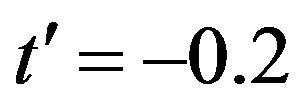 . Figure 56 shows
. Figure 56 shows  as a function of
as a function of  for
for , 3, 4, and 5 with
, 3, 4, and 5 with 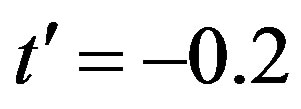 and
and . This shows that
. This shows that
 (112)
(112)
if  is moderately large. This result shows that a d-wave superconducting Kosterlitz-Thouless transition may exist for the repulsive interaction if we adjust the band parameters in the region of optimal doping.
is moderately large. This result shows that a d-wave superconducting Kosterlitz-Thouless transition may exist for the repulsive interaction if we adjust the band parameters in the region of optimal doping.
5. Summary
We have investigated the superconductivity of electronic origin on the basis of the (single-band and three-band) two-dimensional Hubbard model. First, we employ the variational Monte Carlo method to clarify the phase diagram of the ground state of the Hubbard model. The superconducting condensation energy per site obtained by the Gutzwiller ansatz is reasonably close to experimental value . We have examined the stability of striped and checkerboard states in the under-doped region. The relation of the incommensurability and hole density,
. We have examined the stability of striped and checkerboard states in the under-doped region. The relation of the incommensurability and hole density,  , is satisfied in the
, is satisfied in the
lower doped region. We have found that the  period checkerboard spin modulation is stabilized in the two-dimensional Hubbard model with the Bi-2212 type band structure.
period checkerboard spin modulation is stabilized in the two-dimensional Hubbard model with the Bi-2212 type band structure.
We have further performed investigation by using the quantum Monte Carlo method that is an exact unbiased method. We have presented an algorithm of the quantum Monte Carlo diagonalization to avoid the negative sign problem in quantum simulations of many-fermion systems. We have computed d-wave pair correlation functions. In the half-filled case  is suppressed for the repulsive
is suppressed for the repulsive , and when doped away from half-filling
, and when doped away from half-filling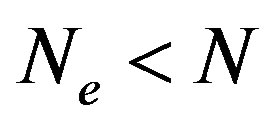 ,
,  is enhanced slightly for
is enhanced slightly for . It is noteworthy that the correlation function
. It is noteworthy that the correlation function  is indeed enhanced and is increased as the system size increases in the 2D Hubbard model. The enhancement ratio increases almost linearly
is indeed enhanced and is increased as the system size increases in the 2D Hubbard model. The enhancement ratio increases almost linearly  as the system size is increased, which is an indication of the existence of superconductivity. Our criterion is that when the enhancement ratio as a function of the system size
as the system size is increased, which is an indication of the existence of superconductivity. Our criterion is that when the enhancement ratio as a function of the system size  is proportional to a certain power of
is proportional to a certain power of , superconductivity will be developed. This ratio depends on
, superconductivity will be developed. This ratio depends on  and is reduced as
and is reduced as  is decreased. The dependence on the band filling shows a dome structure as a function of the electron density. In the
is decreased. The dependence on the band filling shows a dome structure as a function of the electron density. In the  system, the ratio is greater than 1 in the range
system, the ratio is greater than 1 in the range . Let us also mention on superconductivity at half-filling. Our results indicates the absence of superconductivity in the half-filling case because there is no enhancement of pair correlation functions
. Let us also mention on superconductivity at half-filling. Our results indicates the absence of superconductivity in the half-filling case because there is no enhancement of pair correlation functions
6. Acknowledgements
We thank I. Hase, S. Koikegami, S. Koike and J. Kondo for stimulating discussions. This work was supported by a Grant-in Aid for Scientific Research from the Ministry of Education, Culture, Sports, Science and Technology of Japan, and CREST Program of Japan Science and Technology Agency. A part of numerical calculations was performed at the facilities in the Supercomputer Center of the Institute for Solid State Physics of the University of Tokyo.